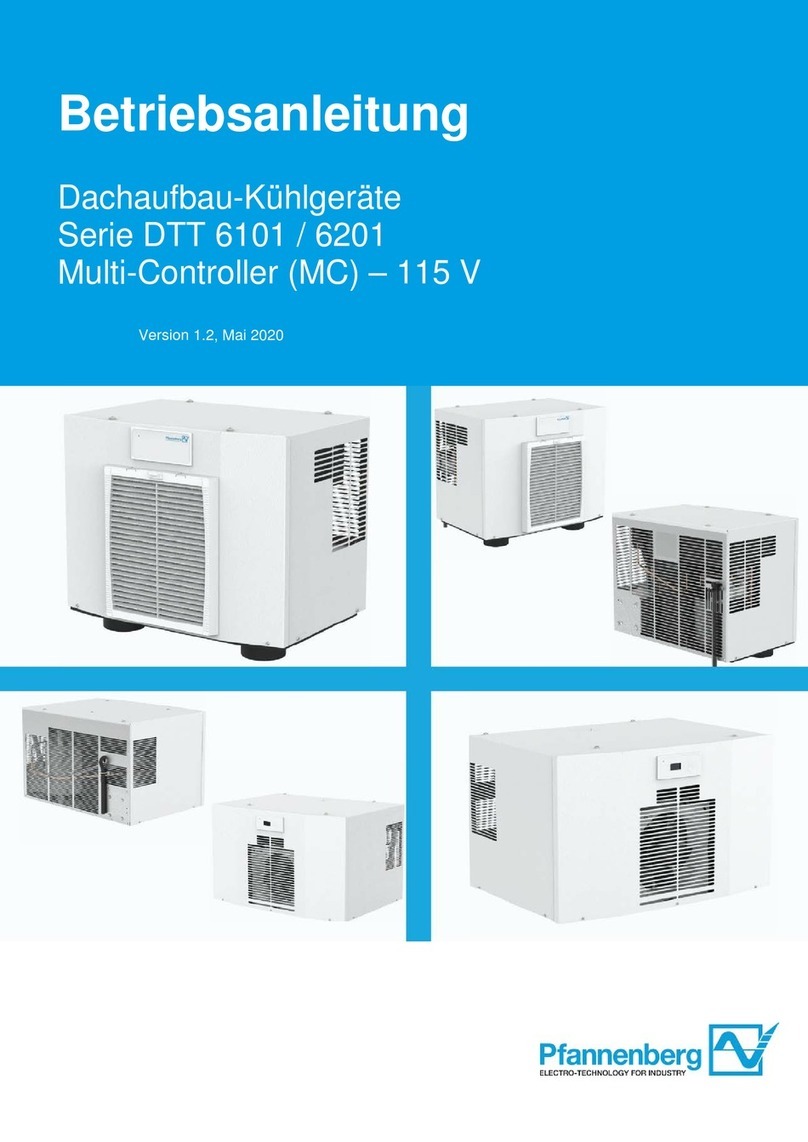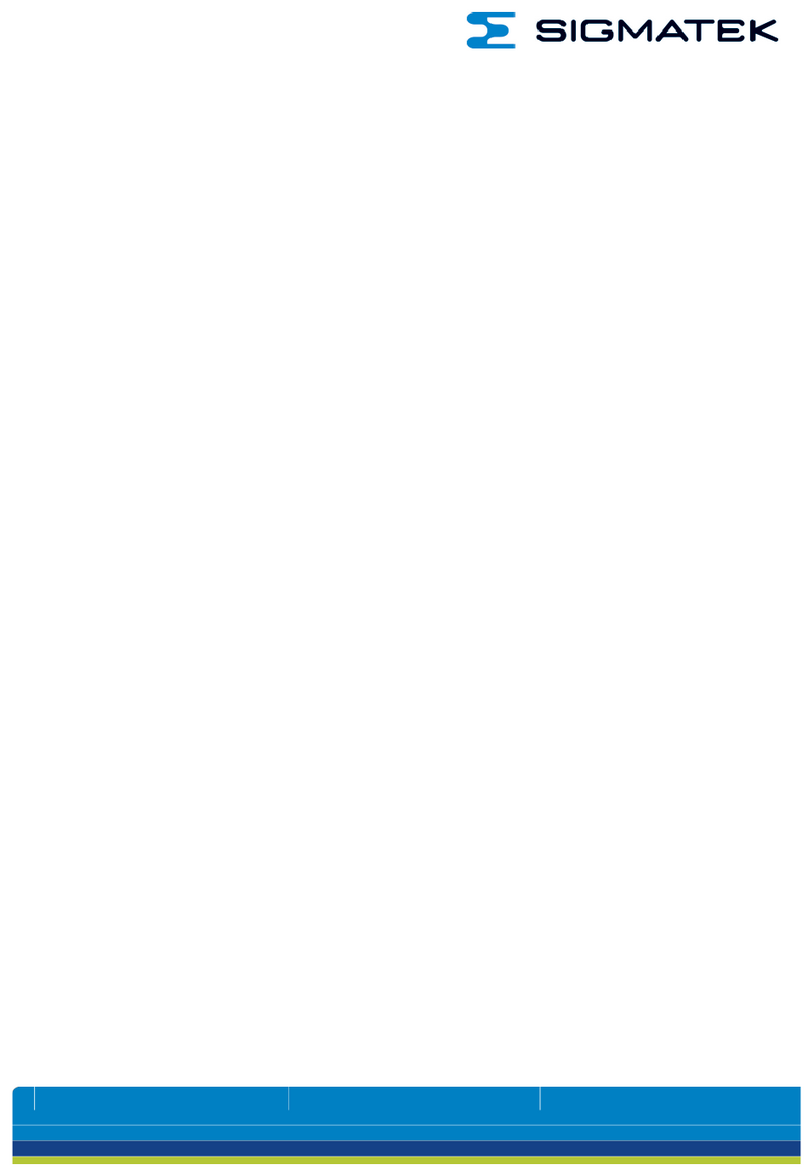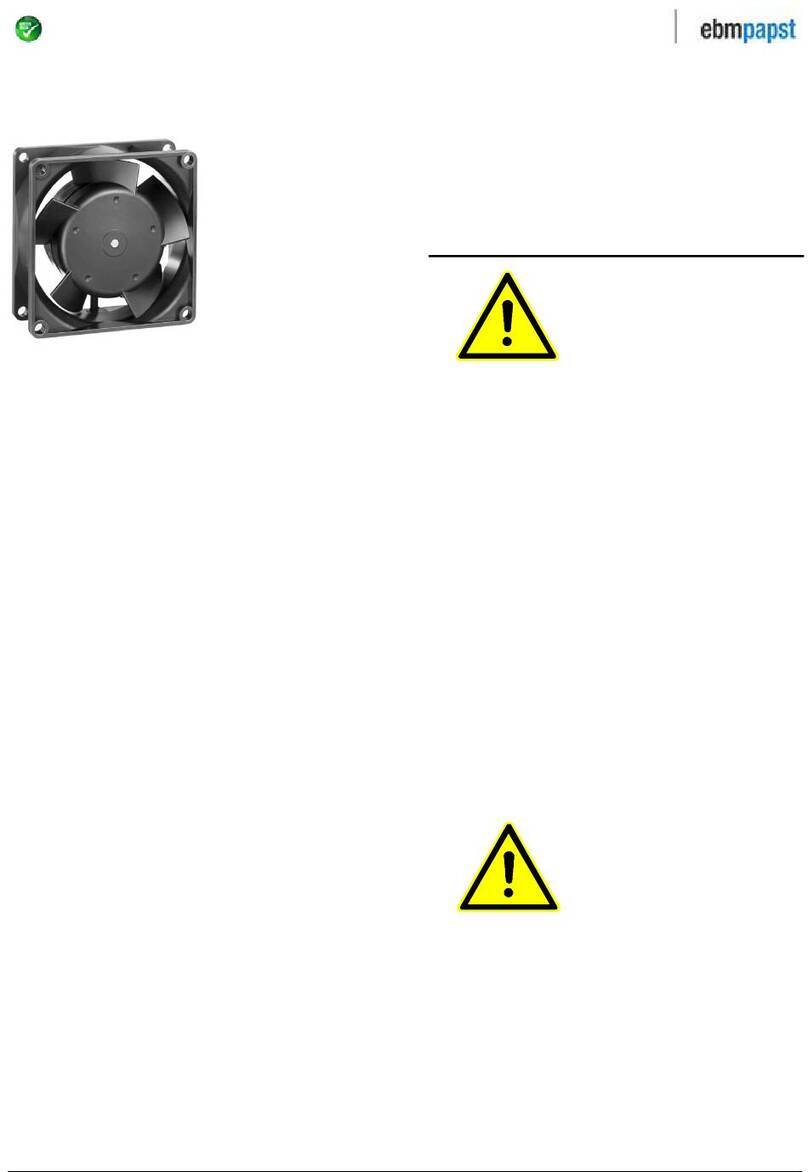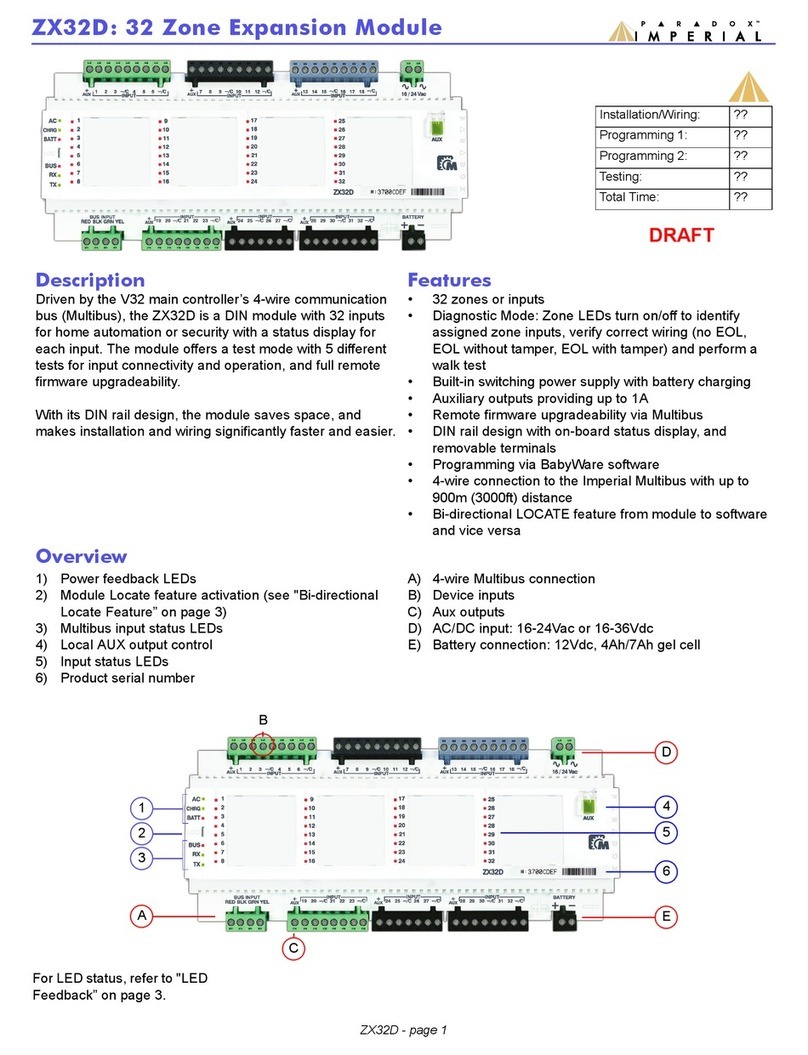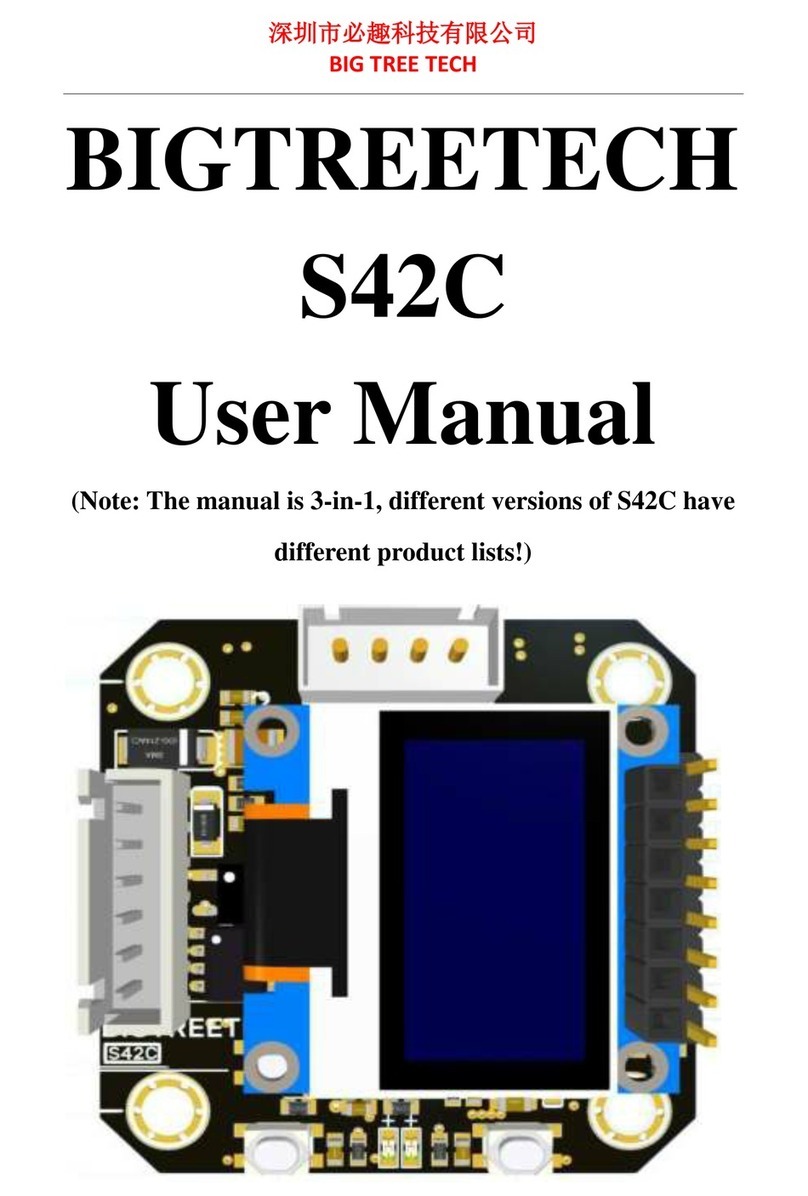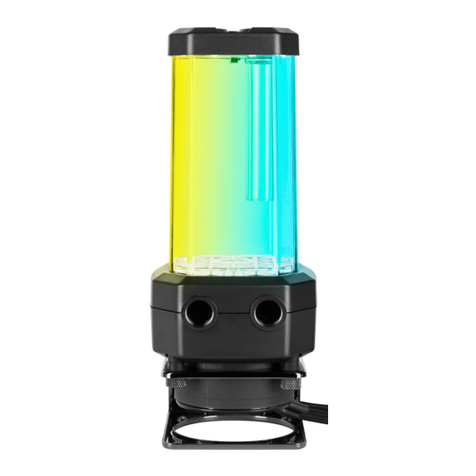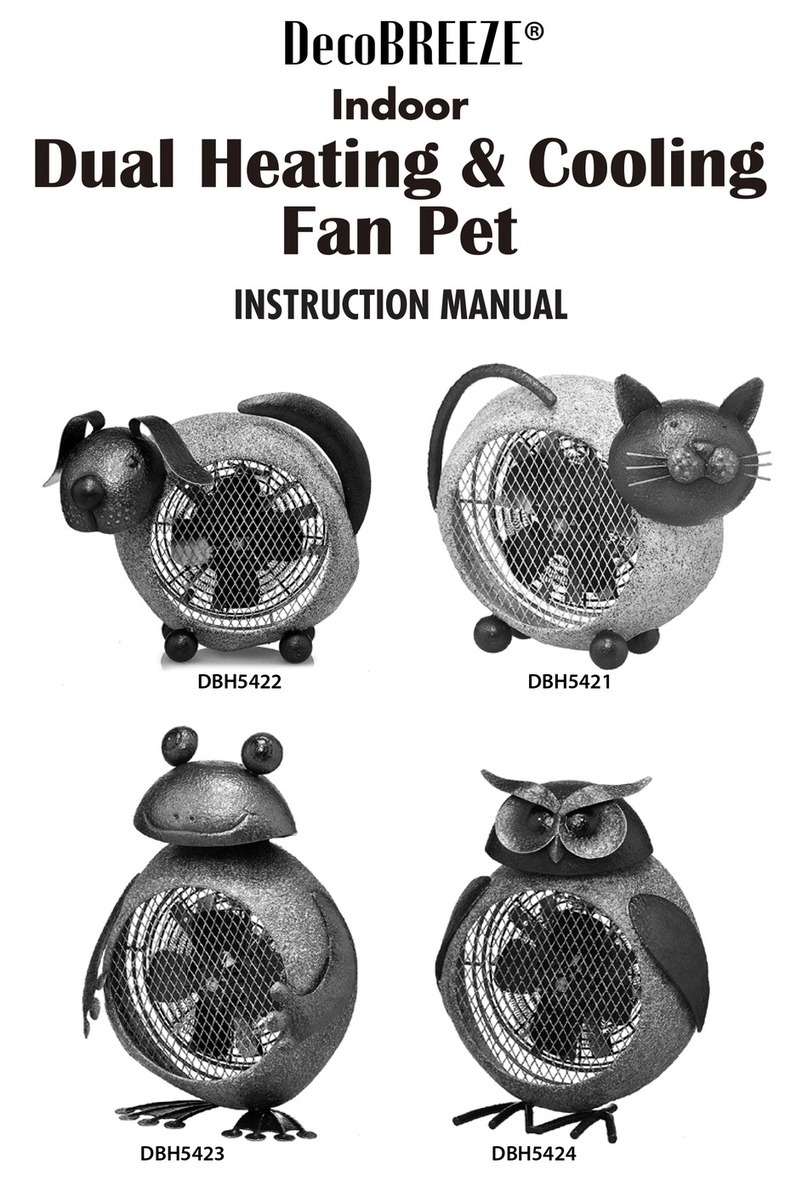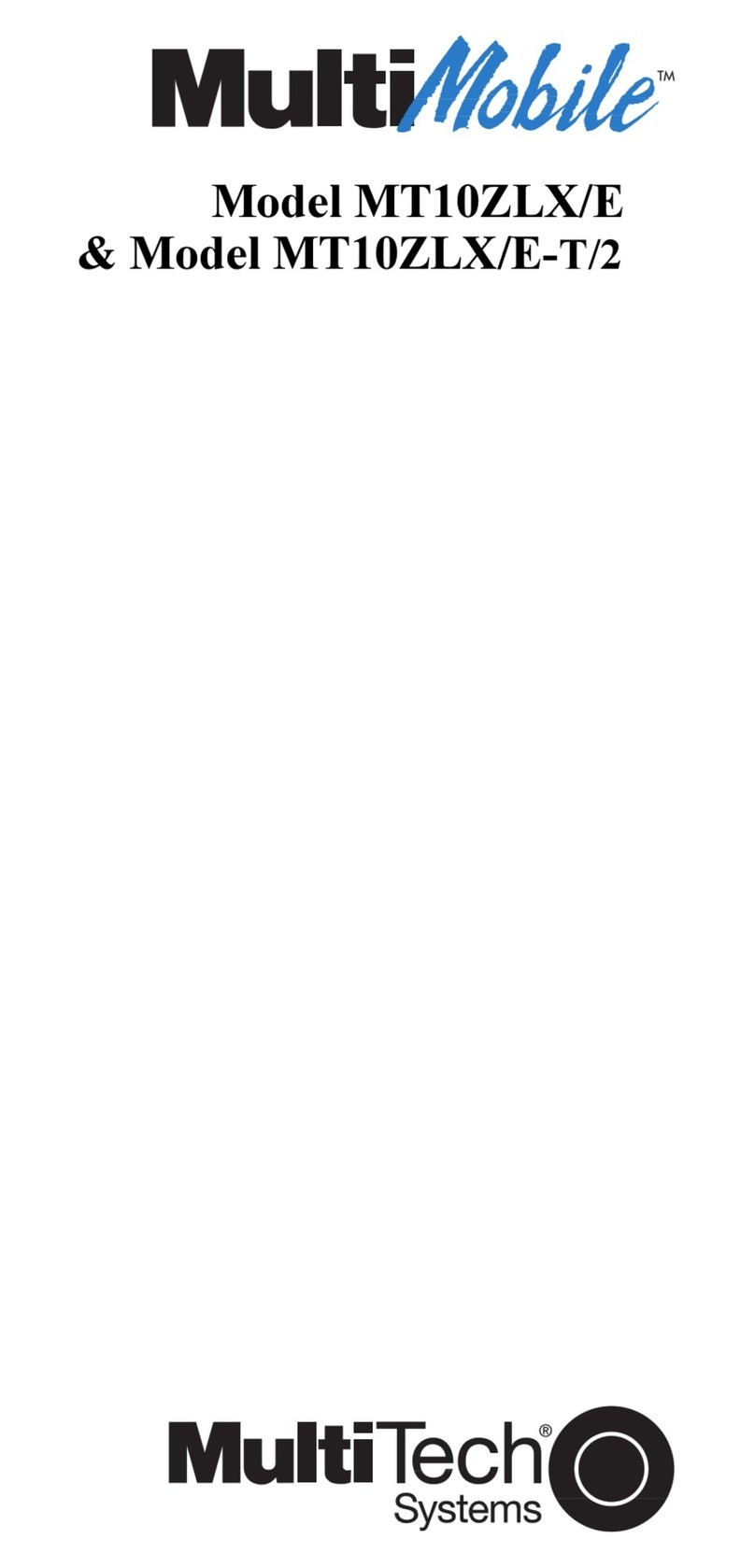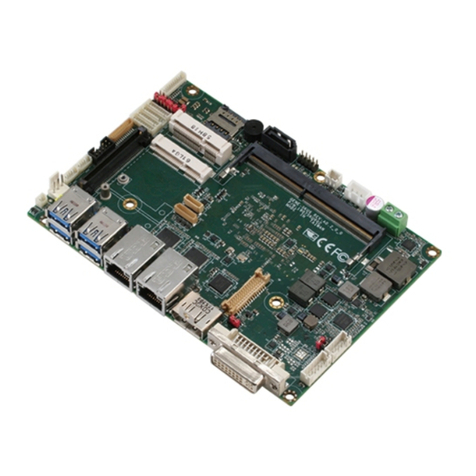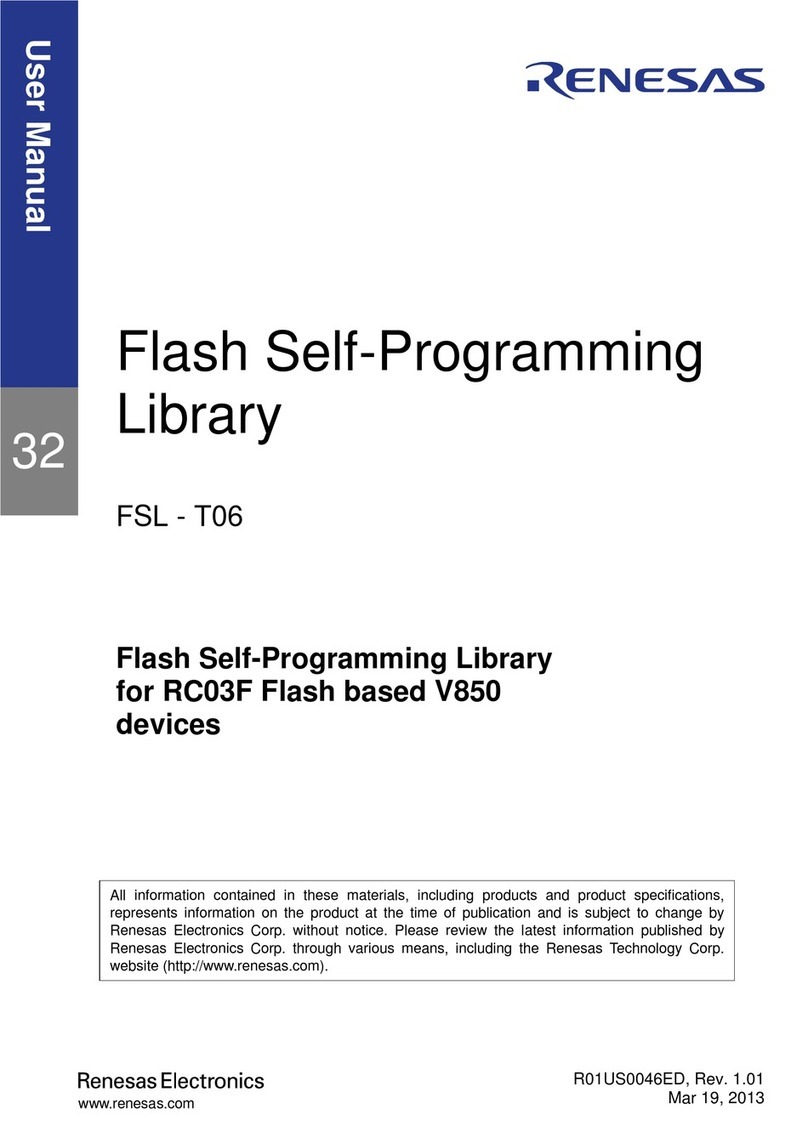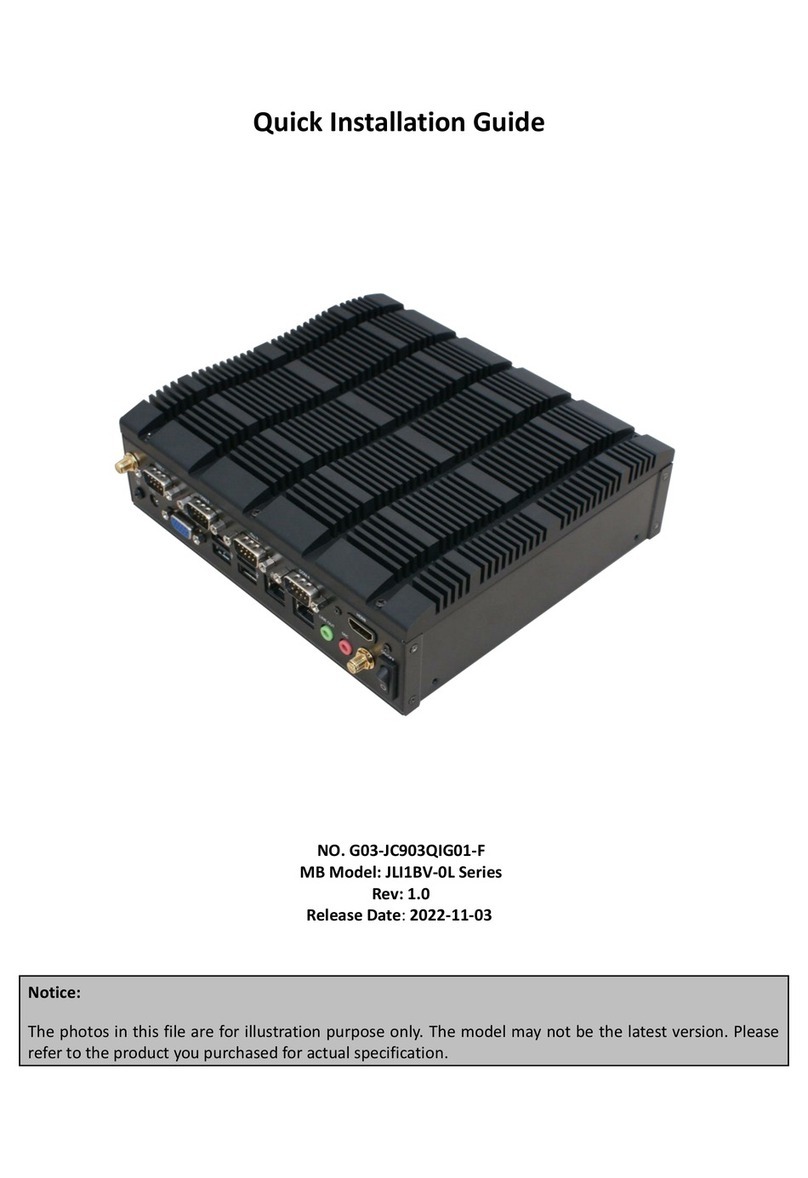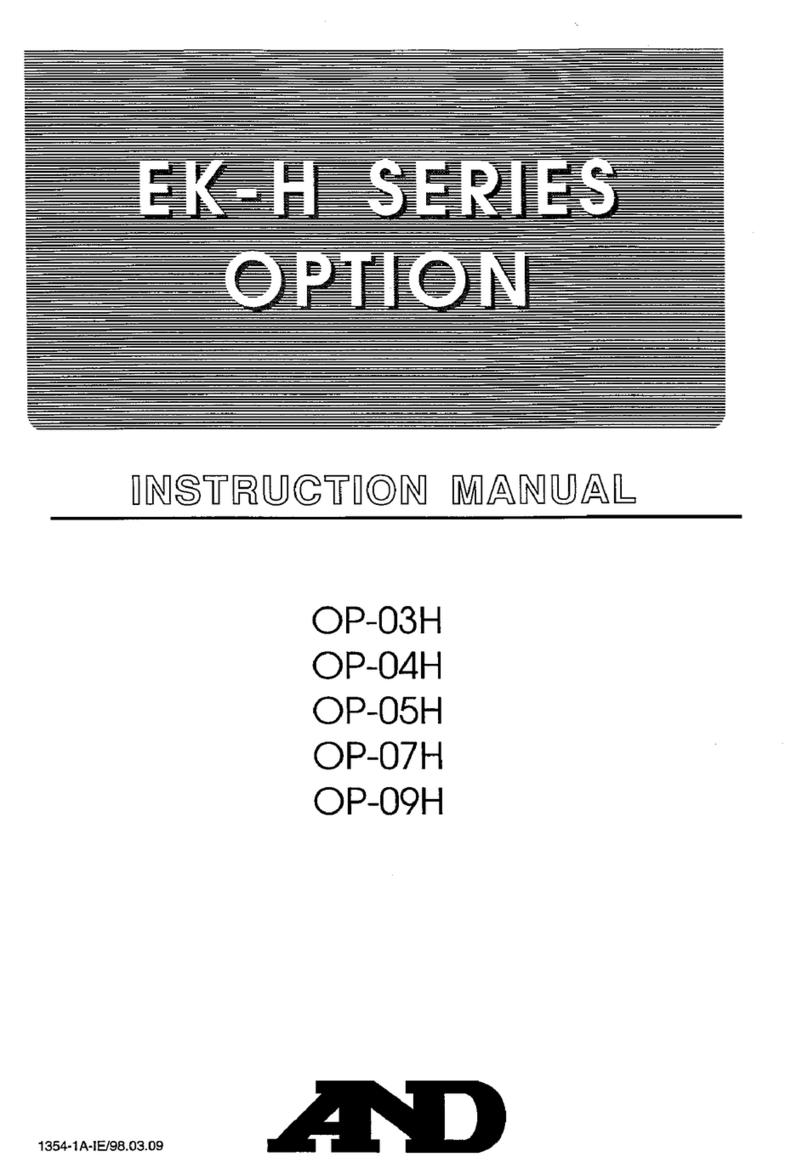Pfannenberg DTS series User manual

Betriebs- und Montageanleitung für
Anbau- und Einbau-Kühlgeräte Serie DTS,
DTI und DTFI
Operating and installation instructions si-
de-mounted and built-in cooling units se-
ries DTS, DTI and DTFI
Manual de Operação e de Instalação para
aparelhos de refrigeração de montagem
lateral e embutidos da série DTS, DTI e
DTFI
GB
D
BR

Betriebs- und Montageanleitung
für Anbau- und Einbau-Kühlgeräte
Serie DTS, DTI und DTFI 3
Operating and installation instructions
side-mounted and built-in cooling units
series DTS, DTI and DTFI 10
Manual de Operação e de Instalação para
aparelhos de refrigeração de montagem
lateral e embutidos da
série DTS, DTI e DTFI 17
D
GB
BR

D
985408000a 3/24
Inhalt
1 Hinweise zum Handbuch ....................................................3
2 Handhabung.........................................................................3
2.1 Transport.................................................................................3
2.2 Lagerung .................................................................................3
2.3 Auspacken...............................................................................3
3Lieferumfang und Optionen ...............................................4
3.1 Lieferumfang ...........................................................................4
3.2 Optionen..................................................................................4
4Allgemeine Angaben...........................................................4
5Typenschild und technische Daten ...................................4
6Sicherheit.............................................................................4
7Funktion ...............................................................................4
7.1 Funktionsprinzip ......................................................................4
7.2 Kondensat ...............................................................................4
8Montage................................................................................5
8.1 Allgemeines.............................................................................5
8.2 Montage Einbau-Kühlgerät DTI...............................................5
8.3 Montage Anbau-Kühlgerät DTS / DTFI...................................5
8.4 Elektrischer Anschluss ............................................................6
9Betriebsbedingungen..........................................................6
10 Inbetriebnahme und Funktion............................................6
10.1 Allgemeines............................................................................6
10.2 Anzeigeelemente.....................................................................6
10.3 Testmodus / Anlauf .................................................................6
10.4 Geräteverhalten.......................................................................7
10.5 Türkontakt ...............................................................................7
10.6 Sammelstörmeldung ...............................................................7
10.7 Einstellmöglichkeiten...............................................................7
11 Reinigung und Wartung......................................................7
11.1 Reinigung ................................................................................7
11.2 Wartung...................................................................................7
12 Außerbetriebnahme.............................................................7
12.1 Entsorgung..............................................................................7
13 Was tun, wenn ... .................................................................8
13.1 Allgemeine Fehler ...................................................................8
13.2 Fehlerdiagnose ......................................................................8
13.3Pfannenberg-Geräte mit Standard-Controller .........................9
14 Gewährleistungsbestimmungen........................................9
Lesen Sie dieses Handbuch vollständig und auf-
merksam durch, bevor das Gerät installiert wird.
Das Handbuch ist fester Bestandteil des Liefer-
umfangs und muss bis zum Abbau des Gerätes
aufbewahrt werden.
1 Hinweise zum Handbuch
Dieses Handbuch erläutert Montage und Betrieb der
•Tür- und Seiteneinbau-Kühlgeräte der Serie DTI/DTFI,
•Tür- und Seitenanbau-Kühlgeräte der Serie DTS.
Hinweis
Die technischen Daten zum jeweiligen Gerät sowie ggf. weitere
Informationen über Montage, Anschluss und Betrieb finden Sie im
separaten Datenblatt.
Die Formulierung der Sicherheits- und Informationshinweise in
diesem Handbuch erfolgt nach der folgenden Struktur:
Gefahr!
Bedeutet, dass bei Nichtbeachtung der nachfolgend be-
schriebenen Maßnahmen Gefahr für Leben und Gesundheit
besteht.
Gefahr!
Bedeutet, dass bei Nichtbeachtung der nachfolgend be-
schriebenen Maßnahmen Gefahr für Leben und Gesundheit
durch Stromschlag besteht.
Achtung!
Bedeutet, dass bei Nichtbeachtung der nachfolgend be-
schriebenen Maßnahmen die Möglichkeit von Sachschäden
besteht.
Hinweis
Enthält vertiefende Informationen zur jeweils beschriebenen Hand-
lung oder Anweisung.
2 Handhabung
2.1 Transport
•Kühlgerät nur am Gehäuse.
•Kühlgerät nur in Gebrauchslage transportieren.
•Falls der gesamte Schaltschrank transportiert werden soll, vorher
das Kühlgerät abbauen und getrennt verpackt transportiern.
Nichtbeachtung hat den Verlust der Gewährleistung zur Folge.
2.2 Lagerung
•Kühlgerät während der Lagerung nicht Temperaturen über
+70 °C aussetzen.
•Kühlgerät nur in Gebrauchslage lagern.
Nichtbeachtung hat den Verlust der Gewährleistung zur Folge.
2.3 Auspacken
• Vor und beim Auspacken des Kühlgerätes Sichtkontrolle durch-
führen, um eventuelle Transportschäden festzustellen. Dabei auf
lose Teile, Beulen, Kratzer, sichtbare Ölverluste etc. achten.
Eventuelle Schäden sind sofort dem Transportunternehmen zu
melden („Bestimmungen für Schadensfälle“ beachten). Im Übri-
gen gelten die „Allgemeinen Bedingungen für Lieferungen und
Leistungen“ des ZVEI (Zentralverband der Elektrotechnischen
Industrie) in der jeweils neuesten Fassung.
•Verpackungsmaterial vor dem Entsorgen auf lose Funktionsteile
überprüfen.
Gefahr!
Gerät kann fertigungsbedingt an Blechkanten Grat aufwei-
sen. Für Service und Montage Handschuhe tragen.
Zur Bearbeitung von Gewährleistungsansprüchen sind genaue
Angaben zum Mangel (evtl. Foto) sowie Angabe der Typbezeich-
nung und Seriennummer des Kühlgerätes erforderlich.

D
985408000a 4/24
3 Lieferumfang und Optionen
3.1 Lieferumfang
Der Lieferumfang besteht aus:
•Kühlgerät (mit Anschluss für Türkontaktschalter),
•Beipack (je nach Gerätetyp u.a. Dichtung, Befestigungsmaterial,
elektrische Steckverbinder),
•gegebenenfalls Sonderzubehör.
3.2 Optionen
Optionen auf Anfrage oder gemäß Katalog.
4 Allgemeine Angaben
•Altgeräte können von Pfannenberg fachgerecht entsorgt wer-
den. Die Anlieferung an eines unserer Herstellwerke hat kosten-
frei zu erfolgen.
• Alle Pfannenberg-Kühlgeräte sind frei von
–Silikonverbindungen,
–PCT,
–Asbest,
–Formaldehyd,
–Cadmium,
–benetzungsstörenden Substanzen.
• Alle Kühlgeräte sind ROHS-konform.
• Alle Kühlgeräte werden im Werk nach UVV-BGV D4 auf Dicht-
heit geprüft.
• Alle Kühlgeräte werden vor der Auslieferung im Werk einer
elektrischen Sicherheitsprüfung unterzogen. Damit entfällt nach
UVV-BGV A2, §5 (4) die Verpflichtung des Betreibers, vor der
ersten Inbetriebnahme eine Prüfung der elektrischen Anlage des
Kühlgerätes auf ordnungsgemäßen Zustand durchzuführen oder
durchführen zu lassen.
5 Typenschild und technische Daten
Für die Installation und Wartung die Angaben auf dem Typenschild
beachten, dieses befindet sich auf der Gehäuserückseite des Kühl-
gerätes.
Die detaillierten technischen Daten des Kühlgerätes finden Sie im
Beiblatt
6 Sicherheit
Pfannenberg-Kühlgeräte sind für die Wärmeableitung aus Schalt-
schränken (IP 54) konzipiert. Bei jeder Kühlung kann Kondenswas-
ser anfallen.
Das Kühlgerät ist nur für den stationären Betrieb geeignet.
Das Kühlgerät darf nur in den auf dem separaten technischen Da-
tenblatt angegebenen Umgebungsbedingungen betrieben werden.
Das Kühlgerät ist weitgehend wartungsfrei (siehe Abschnitt 11).
Jede andere Nutzung gilt als nicht bestimmungsgemäß und hat den
Verlust der Gewährleistung zur Folge.
Die elektrische Ausrüstung muss regelmäßig kontrolliert werden.
Mängel, wie lose Verbindungen bzw. angeschmorte Kabel, müssen
sofort beseitigt werden.
Arbeiten am Kältesystem und an den elektrischen Bauteilen dürfen
nur vom autorisierten Fachpersonal durchgeführt werden. Es sind
die entsprechenden Sicherheits- und Umweltschutzvorschriften zu
beachten.
Gefahr!
Schalten Sie vor Reinigungs- und Wartungsarbeiten das
Kühlgerät spannungsfrei.
Es dürfen nur Original-Ersatzteile verwendet werden.
7 Funktion
7.1 Funktionsprinzip
1 Verdichter
2 Wärmetauscher
(Verflüssiger)
3 Expansionsventil
4 Wärmetauscher
(Verdampfer)
5 Gebläse äußerer Kreis
6 Gebläse innerer Kreis
7 elektronische Steuerung mit Temperaturfühler
Das Kältemittel wird durch den Kompressor (1) auf einen hohen
Druck verdichtet. Dabei steigt die Temperatur an. Im Verflüssiger (2)
wird die Wärme an die Umgebungsluft abgegeben, dabei verflüssigt
sich das Kühlmittel. Das Verflüssigergebläse (5) saugt die Raumluft
durch den Verflüssiger und gibt sie wieder an die Umgebung ab.
Beim Passieren des Expansionsventiles (3) erfährt das Kühlmittel
einen Druckabfall. Im Verdampfer (4) nimmt das Kühlmittel Wärme
aus der Schaltschrankinnenluft auf und verdampft. Dadurch wird die
Luft im Inneren des Schaltschrankes gekühlt. Gleichzeitig wird die
Schaltschrankinnenluft entfeuchtet. Das Verdampfergebläse (6)
saugt die Schaltschrankinnenluft über den Verdampfer ab und führt
diese dem Schaltschrank gekühlt wieder zu.
Das Kühlgerät wird elektronisch gesteuert. Dazu erfasst ein Tempe-
raturfühler die Temperatur der angesaugten Schaltschrankinnenluft
(7).
Das verwendete Kältemittel ist für die Ozonschicht unschädlich und
es ist schwer entzündbar.
7.2 Kondensat
Bei der Abkühlung am Verdampfer fällt die der Luft entzogene
Feuchtigkeit als Kondensat an. Um Schäden am Schaltschrank und
am Kühlgerät zu vermeiden, muss das Kondensat abgeführt wer-
den.
Das Kondensat wird auf folgende Art abgeführt:
•Bei der normalen Kondensatabführung wird das Kondensat in
einer Wanne aufgefangen und über einen Schlauch abgeführt.
Es muss immer darauf geachtet werden, dass ein einwandfreier
Kondensatablauf (Sicherheitsablauf) gewährleistet ist.
Ein übermäßiger Kondensatanfall ist z. B. möglich, wenn der
Schaltschrank nicht dicht ist oder die Innentemperatur des Schalt-
schrankes häufig unter dem Taupunkt liegt

D
985408000a 5/24
Achtung!
Sollte während des normalen Betriebszustandes ungewöhn-
lich viel Kondensat anfallen, überprüfen Sie die Dichtungen
am Schaltschrank.
Um übermäßigen Kondensatanfall bei geöffnetem Schalt-
schrank zu vermeiden, empfehlen wir die Installation eines
Türkontaktschalters zum Abschalten des Kühlgerätes beim
Öffnen der Schaltschranktür.
8 Montage
8.1 Allgemeines
•Der Aufstellungsort des Schaltschrankes muss so gewählt wer-
den, dass für eine ausreichende Be- und Entlüftung des Kühlge-
rätes gesorgt ist.
•Der Abstand der Geräte zueinander oder zur Wand muss min-
destens 200 mm betragen.
•Die Luftzirkulation im Schaltschrank darf nicht durch Einbauten
behindert werden.
•Das Gerät muss spannungsfrei sein!
•Der Montageort muss vor starker Verschmutzung geschützt
werden.
Achtung!
Wenn das Kühlgerät an einer Schaltschranktür montiert
wird, muss sichergestellt sein, dass die Scharniere das zu-
sätzliche Gewicht tragen und der Schaltschrank auch beim
Öffnen nicht kippt.
Achtung! Gefährdung der Schaltschrankeinrichtung
durch Späne.
Werden erst zur Montage der Kühlgeräte die notwendigen
Ausschnitte in den Schaltschrank eingebracht, verhindern
Sie, dass Späne in den Schaltschrank gelangen.
8.2 Montage Seitenanbau-Kühlgerät DTI
Die Befestigungsfläche des Schaltschrankes erhält Ausschnitt(e)
und Bohrungen für Luftdurchlassöffnungen und zur Befestigung des
Gerätes entsprechend des Beiblattes.
Die Darstellung des Beiblattes zeigt außerdem die Lage der elektri-
schen Anschlüsse und Luftdurchlassöffnungen.
1) Ausschnitt(e) und Bohrungen für das Kühlgerät einbringen, wenn
im Schaltschrank noch nicht vorhanden (siehe Darstellung im
Beiblatt).
Schnittkante entgraten.
1 Kühlgerät DTI
2 Schaltschrankwand oder-tür
2) Kühlgerät (1) von außen in den Ausschnitt setzen und bis zum
Anliegen der Gerätedichtung am Schaltschrank (2) durchschie-
ben.
3) Auf der Innenseite des Schaltschrankes das Kühlgerät mittels
der mitgelieferten Muttern M6 (A) und Schrauben M6 (D) so fest
anziehen, dass die Dichtung auf 2mm zusammengedrückt wird.
4) Gerätehaube (C) durch lösen der Schrauben(B) (nicht heraus-
drehen –Verliersicherung) und entsprechender Bewegungsrich-
tung Y und Z entfernen.
Bei Bedarf das Erdungskabel von der Haube entfernen.
5) Kondensatablaufschlauch auf Rohr aufstecken (siehe Beiblatt).
Schlauch mit Gefälle verlegen. Bei Bedarf kürzen. Wird der
Schlauch durch ein Anschlussstück + weiteren Schlauch erwei-
tert, ist das zusätzliche Gewicht des Schlauchs ebtsprecgebd
abzufangen, so dass es zu keiner Einschnürung des Schlauchs
kommt.
6) Gerätehaube (C) mit Erdungskabel verbinden und anschließend
durch Schrauben (B) an das Kühlgerät befestigen.
7) Kabel gemäß Anschlussbild (siehe Geräterückseite) an die
Stecker (Beipack) klemmen und an das Gerät anschließen.
- Leiterquerschnitt: 0,5 –2,5mm² , bzw. AWG20 - AWG14
(Bei der Auswahl des Kabelquerschnittes sind die relevanten
Bestimmungen zu berücksichtigen!)
8) Kühlgerät elektrisch anschließen (siehe Abschnitt 8.4).
8.3 Montage An- und Einbau-Kühlgerät DTS/DTFI
Die Befestigungsfläche des Schaltschrankes erhält einen Rechteck-
ausschnitt entsprechend des Beiblattes.
Die Darstellung des Beiblattes zeigt die Lage der Luftdurchlassöff-
nungen.
1) Ausschnitt für das Kühlgerät herausschneiden, wenn im Schalt-
schrank noch nicht vorhanden (siehe Darstellung im Beiblatt).
Schnittkante entgraten.
2) Bei DTFI-Geräten Gerätehaube (C) durch lösen der Schrauben
(B) (nicht herausdrehen –Verliersicherung) und entsprechender
Bewegungsrichtung Y und Z entfernen (siehe Beiblatt).
Das Erdungskabel von der Haube entfernen.
1. Bei DTFI-Geräten Kühlgerät (1) von innen in den Ausschnitt
setzen und bis zum Anliegen der Gerätedichtung am Schalt-
schrank (2) durchschieben. Schnappfeder (3) an der Geräte-
oberseite rastet hörbar ein und sichert das Gerät vor dem Her-
ausfallen.
Bei DTS-Geräten Kühlgerät (5) mit Dichtungsmaterial (6) bekle-
ben und von außen an den Ausschnitt des Schaltschrankes (2)
setzen.
1 Kühlgerät DTI
2 Schaltschrankwand oder -tür
3 Schnappfeder
4 Kondensatablaufschlauch
5 Kühlgerät DTS
6 Dichtung
4) Die im Beipack mitgelieferten Spannbleche (A) und Schrauben
in das Gehäuse des Kühlgerätes einschrauben und so fest an-
ziehen, dass die Dichtung auf 2mm zusammengedrückt wird.
5) Kondensatablaufschlauch auf Rohr aufstecken /(siehe Beiblatt).
Schlauch mit Gefälle verlegen. Bei Bedarf kürzen. Wird der
Schlauch durch ein Anschlussstück + weiteren Schlauch erwei-
tert, ist das zusätzliche Gewicht des Schlauchs entsprechend
abzufangen, so dass es zu keiner Enschnürung des Schlauchs
kommt.

D
985408000a 6/24
6) Bei DTFI-Geräten Gerätehaube (C) mit Erdungskabel verbinden
und anschließend durch Schrauben (B) an das Kühlgerät Haube
anstecken und diese an dem Kühlgerät gefestigen.
7) Kabel gemäß Anschlussbild (siehe Geräterückseite) an die
Stecker (Beipack) klemmen und an das Gerät anschließen.
- Leiterquerschnitt: 0,5 –2,5mm² , bzw. AWG20 - AWG14
(Bei der Auswahl des Kabelquerschnittes sind die relevanten
Bestimmungen zu berücksichtigen!)
8) Kühlgerät elektrisch anschließen (siehe Abschnitt 8.4).
8.4 Elektrischer Anschluss
Achtung!
•Das Kühlgerät muss über eine Trennvorrichtung an das Netz mit
mindestens 3 mm Kontaktöffnung im ausgeschalteten Zustand
angeschlossen werden.
•Dem Kühlgerät darf einspeiseseitig keine Temperaturregelung
vorgeschaltet werden.
•Als Leitungsschutz muss die auf dem Typenschild angegebene
Sicherung vorgeschaltet werden.
•Der elektrische Anschluss und eventuelle Reparaturen dürfen
nur von autorisiertem Fachpersonal durchgeführt werden.
Versorgungsanschluss (Netz):
Netzspannung und Netzfrequenz müssen mit den am Typenschild
des Kühlgerätes angegebenen Nennwerten übereinstimmen.
Achtung! Zerstörung des Kühlgerätes durch zu hohe
Spannung.
Betrifft die Kühlgeräte für Nennspannung 400V/440V.
Optional können einige Gerät, abweichend vom Standard
(400V/460V), an eine andere Netzspannung angeschlossen
werden (Spannungsbereich siehe Beiblatt). Die Zuleitung
auf der Primärseite des Transformators muss dafür umge-
klemmt werden.
Türkontakt:
Der Türkontakt wird aus dem Kühlgerät mit einer Kleinspannung
(<20V, 20 mA) versorgt.
•Um Störeinflüsse zu vermeiden, wird empfohlen, ein geschirmtes
Kabel mit paarig verdrillten Leitungen zu verwenden. Der Schirm
kann einseitig an die am Kühlgerät dafür vorgesehene PE-
Klemme aufgelegt werden.
•Ist der Einsatz von geschirmten Kabeln nicht möglich, so ist bei
der Verlegung des Kabels darauf zu achten, dass diese nicht in
direkter Nachbarschaft zu potentiellen Störquellen (z.B. Versor-
gungsleitungen, Komponenten mit erhöhter elektromagnetischer
Ausstrahlung) geführt werden.
Achtung! Es darf keine Fremdspannung angelegt
werden.
Wird kein Türkontaktschalter verwendet, so sind die An-
schlusskontakte zu überbrücken.
Sammelstörmeldung:
Zum Anschluss der Störmeldeleitung stehen zwei Anschlusskontak-
te zur Verfügung (siehe Anschlussbild).
Die Verlegung der Störmeldeleitung unterliegt keinen besonderen
Anforderungen.
Achtung! Der Kontakt darf mit max. 230V, 1A belastet
werden.
9 Betriebsbedingungen
•Die Spannung muss innerhalb ± 10 % vom angegebenen Wert
liegen. Die Frequenz muss innerhalb ± 3 Hz vom angegebenen
Wert liegen.
•Die Umgebungstemperatur muss unterhalb 45 °C (Optionen
siehe Beiblatt) liegen.
•Das Gerät muss so eingesetzt werden, dass die angegebene
Kälteleistung den tatsächlichen Bedarf decken kann.
•Es darf nur das angegebene Kältemittel verwendet werden.
•Es dürfen nur Original-Ersatzteile verwendet werden.
10 Inbetriebnahme und Funktion
10.1 Allgemeines
Das Kühlgerät ist mit einer elektronischen Steuerung ausgestattet.
Durch einen Temperaturfühler wird die Temperatur der angesaugten
Schaltschrankinnenluft erfasst. Über einen Kodierschalter auf der
Steuerplatine können verschiedene Schaltschrank-Solltemperaturen
sowie obere Grenztemperaturen eingestellt werden (siehe Beiblatt).
Die Überschreitung der Grenztemperatur führt zur Auslösung einer
Störmeldung.
Achtung!
Die Umgebungsbedingungen und Schaltschrankinnen-
temperaturen müssen den Werten im Beiblatt entsprechen.
Achtung! Zu geringe Wärmeabgabe am Wärmetauscher
im Aussenkreislauf (Verflüssiger).
Das Kühlgerät darf nur mit aufgesetzter Haube betrieben
werden, da sonst die Wärmeabgabe am Verflüssiger zu ge-
ring sein kann und das Kühlgerät beschädigt werden kann.
Sofort nach Anlegen der Betriebsspannung geht das Gerät
in den Anlauf-/Testmodus. Im Anschluss läuft das Ver-
dampfergebläse weiter. Verdichter und Verflüssigergebläse
laufen bei Bedarf weiter (die Temperatur-Schaltschwelle
(Tsoll) ist erreicht), oder werden abgeschaltet (die Tempera-
tur-Schaltschwelle (Tsoll) ist unterschritten).
• Der freie Ablauf eventuell anfallenden Kondensates muss für den
störungsfreien Betrieb sichergestellt sein.
10.2 Anzeigeelemente
Das Kühlgerät besitzt eine Betriebsanzeige in Form einer Leuchtdi-
ode in der Außenhaube des Gerätes. Das dauerhafte Leuchten
dieser Anzeige bei angelegter Versorgungsspannung zeigt an, dass
das Gerät sich im normalen Betriebsmodus befindet. Tritt ein Fehler
auf oder befindet sich das Gerät im Anlauf- oder Testmodus, so
leuchtet diese Anzeige in verschiedenen Blinkfolgen, die die
Fehlerdiagnose des Gerätes erleichtern (siehe Abschnitte 10.4 und
13).
10.3 Testmodus / Anlauf
Der Testmodus wird grundsätzlich nach erneutem Anlegen der
Versorgungsspannung unabhängig von den momentanen Umge-
bungsbedingungen aktiviert, wenn der Türkontakt geschlossen ist.
Zunächst durchläuft das Gerät einen 30 Sekunden dauernden
Anlaufmodus, der von einem 30-sekündigen Testmodus gefolgt
wird.

D
985408000a 7/24
10.4 Geräteverhalten
Modus
Zeitverlauf
Verhalten
Anlauf-
modus
t = 0s - < 30s
t = 30s
t = 32s
Keine Funktion
Innenventilator läuft an
Außenventilator und Verdichter laufen
an
Blinkfolge der Betriebsanzeige:
"aus-dunkel-hell-dunkel-aus".
Störmeldekontakt ist geschlossen
Test-
modus
t >34s –64s.
Verdichter und Lüfter bleiben während
des Zeitraums in Betrieb.
Blinkfolge der Betriebsanzeige:
"aus-dunkel-hell-dunkel-aus".
Störmeldekontakt ist geöffnet.
Sollte eine Störung während des
Testmodus auftreten, so geht das
Gerät in den Fehlermodus und die
Betriebsanzeige leuchtet gemäß Feh-
lerzustand
(siehe Kap. Fehlerdiagnose).
Der Anlaufmodus wird zusätzlich immer dann aktiviert, wenn der
Türkontaktschalter geschlossen wird (siehe Abschnitt 10.5).
10.5 Türkontakt
Zur Vermeidung eines erhöhten Kondensatanfalls und aus Sicher-
heitsgründen sollte ein Türkontaktschalter an die vorgesehenen
Klemmen angeschlossen werden (siehe Schaltbild im Gehäusede-
ckel oder im Beiblatt).
Durch Öffnen der Schaltschranktür und damit Öffnen des Schalters
werden alle Motoren des Kühlgerätes sofort abgeschaltet.
Nach Schließen der Tür wird der Anlaufmodus (siehe Abschnitt
10.4) durchlaufen, der für ein zeitverzögertes Wiederanlaufen des
Kühlgerätes sorgt.
10.6 Sammelstörmeldung
Die Signalisierung einer Störung des Kühlgerätes erfolgt durch das
Öffnen eines potentialfreien Kontakts (siehe Abschnitt 13). Hier-
durch wird ebenfalls ein Kabelbruch der Störmeldeleitung signali-
siert.
10.7 Einstellmöglichkeiten
Über einen Kodierschalter können verschiedene Schaltschrank-
Solltemperaturen sowie Grenztemperaturen eingestellt werden.
Die Lage des Kodierschalters auf der Steuerplatine kann dem
Schaltbild entnommen werden.
Die Kodiermöglichkeiten sind auf dem Schaltbild (Standard-
Controller) dargestellt. Das Schaltbild ist auf der Innenseite der
Gerätehaube aufgeklebt und im Beiblatt dargestellt.
Ausgehend von der Solltemperatur im Schaltschrank kann eine
obere Grenztemperatur ausgewählt werden, bei deren Überschrei-
tung eine Störmeldung ausgelöst wird. Werksseitige Einstellung
siehe Beiblatt.
Achtung!
Änderungen an den werksseitig eingestellten Parametern
des Gerätes dürfen nur von autorisierten Personen durchge-
führt werden!
Schalten Sie das Gerät vor Änderung der Kodierschalter-
Einstellung spannungsfrei, da sonst die veränderten Werte
nicht übernommen werden.
11 Reinigung und Wartung
Gefahr!
Schalten Sie vor Reinigungs- und Wartungsarbeiten das
Kühlgerät spannungsfrei.
11.1 Reinigung
Die Häufigkeit der Reinigungsintervalle hängt von den jeweiligen
Betriebsbedingungen ab. Beachten Sie insbesondere:
•Reinigen Sie den Wärmetauscher regelmäßig.
•Reinigen Sie den Wärmetauscher mit einer weichen Bürste oder
Druckluft.
•Wir empfehlen den Kondensatablauf regelmäßig zu kontrollieren.
Hierbei ist folgendermaßen zu verfahren:
1) Kühlgerät spannungsfrei schalten.
2) Abdeckhaube demontieren
3) Wärmetauscher reinigen
Achtung!
Schützen Sie die elektrischen Bauteile vor dem Eindringen
von Wasser.
Achtung! Beschädigung an den Lamellen.
Verwenden Sie keine spitzen oder scharfkantigen Gegen-
stände. Die Lamellen sollen beim Reinigungsvorgang nicht
verdrückt oder beschädigt werden.
Achtung! Beschädigung elektrischer Anschlüsse an
Gerätehaube
Wird die Gerätehaube demontiert, müssen die elektrischen
Steckverbindungen auf der Innenseite von Hand abgezogen
werden. Bei Montage das Anstecken nicht vergessen!
11.2 Wartung
Der Kältekreis, als wartungsfreies hermetisch geschlossenes Sys-
tem, ist werksseitig mit der erforderlichen Kältemittelmenge gefüllt,
auf Dichtheit geprüft und einem Funktionsprobelauf unterzogen
worden. Das Kühlgerät ist weitgehend wartungsfrei. Die Komponen-
ten des äußeren Luftkreislaufes bedürfen je nach Umgebungsbe-
dingungen der Wartung und Reinigung (siehe Abschnitt 11.1).
Nach jeder Wartung muss die volle Leistungsfähigkeit des Konden-
satablaufes überprüft werden.
12 Außerbetriebnahme
Wird das Kühlgerät für längere Zeit nicht benötigt, unterbrechen Sie
die Spannungsversorgung. Achten Sie darauf, dass eine unsach-
gemäße Inbetriebsetzung durch Dritte verhindert wird.
Wird das Kühlgerät nicht mehr benötigt, ist es vom autorisierten
Fachpersonal gemäß den geltenden Umweltschutzvorschriften zu
entsorgen. (siehe auch Abschnitt 4 Allgemeine Angaben). Dabei ist
besonders zu beachten, dass das im Kältesystem befindliche Käl-
temittel fachgerecht abgesaugt wird. Kältemittelemissionen sind zu
vermeiden.
12.1 Entsorgung
Geräte, die mit diesem Symbol gekennzeichnet sind, dürfen nicht
als unsortierter Siedlungsabfall (Hausmüll) entsorgt werden.
Sie sind einer getrennten Sammlung von Elektro- und Elektronik-
geräten zuzuführen.
Für weitere Informationen zur Entsorgung den QR-Code scannen
oder www.pfannenberg.com/disposal aufrufen.

D
985408000a 8/24
13 Was tun, wenn ...
... trotz aller Sorgfalt einmal eine Störung auftritt?
Überprüfen Sie zunächst nachfolgende Punkte. Sollte die Störung dann nicht behoben sein, rufen Sie bitte autorisiertes Fachpersonal
13.1 Allgemeine Fehler
-Keine Meldung über Betriebsanzeige
Störung
mögliche Ursache
Behebung
Gerät kühlt nicht,
Innenlüfter läuft
Temperatureinstellung zu hoch eingestellt.
Temperatureinstellung prüfen.
Gerät kühlt nicht ausreichend
Einsatzgrenzen überschritten.
Kältemittelmangel.
Wärmetauscher verschmutzt.
Innenlüfter defekt. Außenlüfter defekt.
Luftzirkulation im Schaltschrank gestört.
Umgebungstemperatur und innere Belastung prüfen.
Fachpersonal rufen, Gerät auf Dichtigkeit prüfen.
Wärmetauscher reinigen.
Fachpersonal rufen; Lüfter wechseln.
Einbauten und Umlaufwege im Schaltschrank prüfen.
Luft- Zu- und Abströmung vom Kühlgerät in/aus dem Schalt-
schrank muss gewährleistet sein.
Kodierschalter und Kabelanschlüsse prüfen.
Gerät kühlt nur manchmal
Kodierschalter falsch eingestellt oder defekt.
Höhere Temperatur am Kodierschalter einstellen.
Kondensatbildung im Schalt-
schrank
Zu tiefe Ausblastemperatur.
Schaltschrank ist nicht ausreichend abgedichtet.
Schaltschranktür schließen.
Undichtigkeiten am Schaltschrank beseitigen.
Kondensat läuft nicht ab
Kondensatablauf verstopft.
Kondensatablauf reinigen.
Kondensatablaufschlauch muss knickfrei und mit Gefälle
verlegt sein.
Kondensat läuft aus dem
Gerät
Kondensatverdunster defekt oder es fällt zuviel
Kondensat an.
Schaltschrank ist nicht ausreichend abgedichtet.
Sicherungen für Kondensatverdunster tauschen.
Undichtigkeit am Schaltschrank beseitigen.
13.2 Fehlerdiagnose
•Meldung über Betriebsanzeige
Tritt am Kühlgerät eine Störung auf, so geht die Betriebsanzeige in einen Blinkmodus, der in Verbindung mit dem Geräteverhalten eine erste
Fehlerdiagnose erleichtern soll. Blinkfolgen im Fehlermodus können dabei sein:
Betriebsanzeige Blinkfolge 1:
(Anwenderfehler)
(5s, 1s, 1s, 1s) mit periodischer Wiederholung
Betriebsanzeige Blinkfolge 2:
(Gerätefehler)
(1s, 1s) mit periodischer Wiederholung
Betriebsanzeige Blinkfolge 3:
(Test-/Anlaufmodus)
(1s, 1s, 1s, 1s) mit periodischer Wiederholung

D
985408000a 9/24
13.3 Pfannenberg-Geräte mit Standard-Controller
Die nachfolgende Tabelle beschreibt die Technische Ursache als auch die Fehlerbehebung in Abhängigkeit des Geräteverhaltens.
Pos
Geräteverhalten
Technische Ursachen
Fehlerbehebung
1
Verdichter:
Innenlüfter:
Außenlüfter:
Betriebsanzeige:
Störmeldekontakt:
OFF
OFF
OFF
OFF
geöffnet
Es liegt keine Versorgungsspannung am
Gerät an.
Vorsicherung prüfen und/ oder Versorgungsspan-
nung anschließen.
2
Verdichter:
Innenlüfter:
Außenlüfter:
Betriebsanzeige:
Störmeldekontakt:
ON
ON
ON
blinkend (Folge 3)
geöffnet
Der Testmodus des Gerätes ist aktiv. Dieser
Modus wird selbsttätig spätestens nach 60s
verlassen.
Das Gerät geht nach jedem Neuanschluss einmalig
in den Testmodus.
Keine Fehlerbehebung notwendig.
3
Verdichter:
Innenlüfter:
Außenlüfter:
Betriebsanzeige:
Störmeldekontakt:
OFF
OFF
OFF
blinkend (Folge 1)
geschlossen
Der Eingang für den Türkontaktschalter ist
z.B. durch nicht geschlossener Schaltschrank-
tür oder nicht gesetzter Brücke geöffnet.
Brücke einsetzen, Türkontaktschalter anschließen
oder bei eingesetztem Türkontaktschalter Tür
schließen.
4
Verdichter:
Innenlüfter:
Außenlüfter:
Betriebsanzeige:
Störmeldekontakt:
OFF
ON
OFF
blinkend (Folge 2)
geöffnet
Hochdruckpressostat oder Motorschutzschal-
ter hat angesprochen (Überhitzung) oder
Anschlussbelegung falsch.
Verdichter schaltet selbsttätig nach Behe-
bung des Fehlers (Abkühlung) mit einer
Verzögerung von 30s wieder zu.
Filter reinigen bzw. ersetzen oder Wärmetauscher
im Außenkreislauf säubern. Evtl. Überprüfung der
Verlustleistung im Schaltschrank zu der installierten
Kälteleistung des Klimagerätes.
5
Verdichter:
Innenlüfter:
Außenlüfter:
Betriebsanzeige:
Störmeldekontakt:
OFF
OFF
OFF
blinkend (Folge 1)
geöffnet
Die Geräteeinstellung mittels des Kodier-
schalters auf der Steuerelektronik ist nicht
plausibel. Geräteeinstellung muss geändert
werden.
Beachten Sie die Bedienungsanleitung und den
Kodierschlüssel des Kodierschalters.
6
Verdichter:
Innenlüfter:
Außenlüfter:
Betriebsanzeige:
Störmeldekontakt:
ON
ON
ON
blinkend (Folge 1)
geöffnet
Der obere Temperaturgrenzwert (TG2) des
Schaltschranks wurde
überschritten.
Filter reinigen bzw. ersetzen oder Wärmetauscher
im Außenkreislauf säubern.
Überprüfen Sie die Verlustleistung im Schaltschrank
zu der installierten Kälteleistung des Klimagerätes.
7
Verdichter:
Innenlüfter:
Außenlüfter:
Betriebsanzeige:
Störmeldekontakt:
ON
ON
ON
blinkend (Folge 2)
geöffnet
Der Temperaturfühler TS1 ist defekt oder
wurde nicht erkannt.
Den Temperaturfühler TS1 auswechseln oder
gesamte elektronische Steuerung mit fest verdrahte-
tem Temperaturfühler wechseln.
Kontaktieren Sie den Service.
8
Verdichter:
Innenlüfter:
Außenlüfter:
Betriebsanzeige:
Störmeldekontakt:
normales Regelverh.
ON
normales Regelverh.
blinkend (Folge 1)
geöffnet
Im Schaltschrank hat sich ein Luftkurz-
schluss* eingestellt d.h. es ist keine effektive
Kühlung des Schaltschranks möglich. Der
Kühlbetrieb wird innerhalb kurzer Zykluszei-
ten angefordert.
Versetzen Sie die Leistungskomponenten im
Schaltschrank oder versetzen Sie das Kühlgerät.
Wählen Sie je nach Platzverhältnissen ein Dachauf-
bau Kühlgerät oder Seitenanbau Kühlgerät als
Alternative.
* Luftkurzschluss: Ein Luftkurzschluss entsteht, wenn die kühle Luft am Luftaustritt des Kühlgerätes mittels ungünstig direkt davor gebauter Leistungskomponen-
ten nicht in den Schaltschrank, sondern direkt zum Lufteintritt des Kühlgerätes geleitet wird. Die Folge ist eine Überhitzung der Leistungskomponenten durch
fehlende Kühlung.
14 Gewährleistungsbestimmungen
Die Gewährleistung gilt nicht bzw. erlischt:
•bei unsachgemäßem Gebrauch des Gerätes, Nichteinhaltung
der Betriebsbedingungen oder Nichtbeachtung der Anleitung;
•bei Betrieb in Räumen mit ätzender oder säurehaltiger Luft;
•für Schäden durch verschmutzte oder verstopfte Luftfilter;
•wenn der Kältekreislauf unbefugt geöffnet wird, Modifikationen
am Gerät vorgenommen werden oder die Seriennummer verän-
dert wird;
•für Transportschäden oder andere Unfälle;
•für den Austausch von Teilen durch Fremdfirmen.
Zur Erhaltung Ihres Gewährleistungsanspruches beachten Sie bitte
bei Rücksendung des Gerätes folgendes:
•Legen Sie dem Kühlgerät eine genaue Beschreibung des Defek-
tes bei.
•Legen Sie den Bezugsnachweis (Lieferschein- oder Rechnungs-
kopie) bei.
•Senden Sie uns das Kühlgerät mit allem Zubehör im Originalkar-
ton oder mindestens gleichwertiger Verpackung frachtfrei und
transportversichert zu. Bitte achten Sie auf die Transporthinwei-
se im Abschnitt 2.

GB
985408000 10/24
Contents
1 Hints on the manual..........................................................10
2 Handling.............................................................................10
2.1 Transport...............................................................................10
2.2 Storage....................................................................................9
2.3 Unpacking ...............................................................................9
3Scope of delivery and options .........................................11
3.1 Scope of delivery...................................................................11
3.2 Options..................................................................................11
4General Information ..........................................................11
5ID Plate and Technical Data..............................................11
6Safety..................................................................................11
7Function .............................................................................11
7.1 Principles of function .............................................................11
7.2 Condensate...........................................................................11
8Installation..........................................................................12
8.1 General..................................................................................12
8.2 Installation of built-in cooling unit DTI....................................12
8.3 Installation of bolt-on and built-in cooling unit DTS/DTFI......12
8.4 Power connection..................................................................13
9Operating Conditions........................................................13
10 Putting into operation and function.................................13
10.1 General remarks...................................................................13
10.2 Indicator elements.................................................................13
10.3 Test mode / Start-up..............................................................13
10.4 Unit characteristics................................................................14
10.5 Door contact..........................................................................14
10.6 Centralised fault indication ....................................................14
11 Cleaning and Maintenance.................................................14
11.1 Cleaning ................................................................................14
11.2 Maintenance..........................................................................14
12 Stopping.............................................................................14
12.1 Disposal.................................................................................14
13 What to do if ......................................................................15
13.1General errors .......................................................................15
13.2 Fault diagnosis ......................................................................15
13.3 Pfannenberg units with Standard-Controller .........................16
14 Warranty Conditions .........................................................16
Read this manual completely and carefully before
installing the unit.
This manual is an integral part of the scope of
delivery and must be kept until the unit is dis-
posed of.
1 Hints on the manual
This handbook contains instructions for the installation and opera-
tion of
•Door and side-mounted, built -in Cooling Units,
Series DTI/DTFI,
•Door and side-mounted, bolt-on Cooling Units, Series DTS.
Hint
The technical specifications for each machine along with additional
information on assembly, connections and operation are contained
in a separate sheet.
In this manual, safety recommendations and other information are
structured as follows:
Hazard!
If the measures described in the following are not strictly
observed there is danger to life and health.
Hazard!
If the measures described in the following are not strictly
observed there is danger to life and health due to electrical
shock.
CAUTION!
If the measures described in the following are not strictly
observed material damage may be caused.
Hint
A hint contains additional information on the action or instruction
described.
2 Handling
2.1 Transport
•Lift cooling unit by the casing only)
•Transport the cooling unit only in condition of usage.
•If the complete switch cabinet is to be transported, remove the
cooling unit prior to transportation and pack it speparately
Failure to abserve these instructions will render the warranty provi-
sions null and void.
2.2 Storage
•Never expose cooling units to temperatures exceeding +70 °C
during storage.
•Store cooling unit only in condition of usage.
Failure to observe these instructions will render the warranty provi-
sions null and void.
2.3 Unpacking
•Prior to and during unpacking make a visual inspection of the
cooling unit to see whether any damage has occurred during
transport. Especially pay attention to loose parts, dents, scratch-
es, visible loss of oil etc.
•Any damage must be reported immediately to the forwarding
agent (follow the instructions in "Rules for Damage Claims").
Moreover, the latest edition of the "General Conditions for Sup-
plies and Services" issued by the ZVEI (Central Association for
the German Electrotechnical Industry") shall apply.
•Before disposing of packing material ensure that it does not
contain any loose components.
Danger!
Burr caused by production may be present on the metal
edges of the unit. Always wear protective gloves when car-
rying out maintenance work and installation.
In case of a warranty claim exact details on the fault (photograph, if
possible) and the indication of type and serial number of the cooling
unit are required.

GB
985408000 11/24
3 Scope of delivery and options
3.1 Scope of delivery
The Scope of delivery includes:
•Cooling unit (with connection for door contact switch)
•Enclosed package (among other things sealing profile, fastening
material, electrical plug-type connectors)
•special accessories, if applicable.
3.2 Options
•Options on request or in accordance with the catalogue.
4 General Information
•Old devices can be properly disposed of by Pfannenberg. They
must be sent to one of our works shipment/postage paid.
•All cooling units produced by Pfannenberg are free from
–silicone compounds,
–PCB,
–PCT,
–asbestos,
–formaldehyde,
–cadmium,
–substances impairing wetting.
•Every cooling unit is checked to ensure that it is tight according
to the provisions of UVV-BGV D4 (German regulations covering
accident prevention).
•Prior to delivery the electrical safety of every cooling unit is
factory tested. This means that, in accordance with UVV-BGV
A2, §5 (4), the operating company is released from the obligation
to arrange for a test of the electrical part of the cooling unit be-
fore initial start of operation.
5 ID Plate and Technical Data
For installation and maintenance, note the data on the ID plate; it is
to be found on the back of the cooling unit casing
The technical details applicable to the cooling unit are in the sup-
plement.
6 Safety
Cooling units produced by Pfannenberg are designed for dissipat-
ing heat from switch cabinets (IP 54). During each cooling process
condensate can be produced. The cooling unit is only suitable for
stationary operation.
The cooling unit may only be used under the ambient conditions
specified on the enclosed sheet.
The cooling unit is to a large measure maintenance-free (see Sec-
tion 11).
Every other use is considered as non-authorized use making any
warranty null and void.
The electrical equipment must be regularly checked. Any faults such
as loose connections or scorched cables must be removed immedi-
ately.
Work on the cooling system and on electrical components may only
be carried out by authorized specialist personnel.
Compliance with applicable safety and environmental regulations is
mandatory.
Hazard!
Isolate the cooling unit from the mains before carrying out
any cleaning or maintenance operations.
Only original spare parts may be used.
7 Function
7.1 Principles of function
1 Compressor
2 Heat exchanger
(condenser)
3 Expansion valve
4 Heat exchanger
(evaporator)
5 fan, exterior circulation
6 fan, inner circulation
7 Electronic control system with temperature sensor
The compressor (1) compresses the refrigerant until high pressure
is achieved. During this process temperature increases. In the
condenser (2) heat is dissipated to ambient air, the coolant becom-
ing liquid. The condenser fan (5) of the condensator takes ambient
air in through the condenser, then it releases the air.
The pressure of the coolant drops as it passes through the expan-
sion device (3). In the evaporator (4) the coolant absorbs heat from
the air in the switch cabinet and evaporates. Thus, the air in the
switch cabinet cools down. At the same time the air inside the switch
cabinet is being dehumidified. The evaporator fan (6) sucks the air
out of the switch cabinet via the evaporator, the cooled air flows
back to the switch cabinet.
The cooling unit is electronically controlled. For that purpose a
temperature sensor records the temperature of the air inside the
switch cabinet (7).
The refrigerant is not detrimental to the ozonosphere; it is hardly
combustible.
7.2 Condensate
During cooling on the evaporator the moisture removed from the air
is collected as condensate. In order to avoid any damage to the
switch cabinet and the cooling unit, the condensate must be dis-
charged.
The condensate is discharged in the following way:
•In case of normal condensate drainage a reservoir collects the
condensate which is then drained by means of a hose
Alwaxs ensure that the condensate is drained properly (safety
drainage).
Excessive condensation can occur if, for example, the switch cabi-
net is not sealed or if the internal temperature of the switch cabinet
is frequently below the dew point.

GB
985408000 12/24
•CAUTION!
If there is excessive condensate during normal operation
check the sealings of the switch cabinet.
We recommend that you install a door contact switch to
switch off the cooling unit, when the door of the switch cabi-
net is opened, in order to prevent excessive condensate.
8 Installation
8.1 General
•The installation place for the switch cabinet must be selected
such that proper ventilation of the cooling unit is ensured.
•The single units or the units and the wall must be at a distance of
200mm at least.
•Air circulation in the switch cabinet must not be impeded by built-
in parts.
•The unit must be disconnected from the power supply!
•The site of installation must be protected against contamination.
CAUTION!
If the cooling unit is mounted on a switch cabinet door, it
must be confirmed that the hinges can support the addition-
al weight or that the switch cabinet will not topple over when
the door is opened.
CAUTION! Chips may damage the switch cabinet.
If the necessary cutouts are only made in the switch cabinet
when the colling units are installed, swarf must be prevented
from entering the switch cabinet.
8.2 Installation of built-in cooling unit DTI
The mounting surface of the switch cabinet is to be provided with
cutout(s) and holes for air ventilation openings and for securing the
unit according to the accompanying sheet.
The drawing on the accompanying sheet also shows the location of
the electrical connections and ventilation openings.
1) Make cutout(s) and drillings for the cooling unit, if not already
provided in the switch cabinet (see drawing on accompanying
sheet).
Remove burrs from the cut edges
1 Cooling Unit DTI
2 Switch cabinet wall or door
2) Insert the cooling unit (1) into the cut-out from the outside and
push through until the unit seal engages with the switch cabinet
(2).
3) Fix the cooling unit on the inside of the switch cabinet by means
of the M6 nuts (A) provided. Tighten M6 (D) so that the seal is
compressed to a thickness of 2mm.
4) Remove the device hood (C) in the appropriate direction of
movement Y and Z by loosening the screws (B) (do not remove
the screws as a safeguard against loss).
Remove the earth cable from the hood if necessary.
5) Fit the condensate train tube to the pipe (see accompanying
sheet). Lay the tube with a downward fall. Shorten as required.
If the tube has been extended by means of a connector and a
further tube, the additional weight of the tube must be appropri-
ately supported so that it does not become constricted
6) Connect the device hood (C), to the earth cable and then fix to
the cooling unit by means of the screws (B).
7) Clamp cables in accordance with the connection diagram (see
rear of unit) to the plug-in connectors (enclosed package) and
connect to the unit.
- lead cross-section: 0,5 –2,5mm² or AWG20 - AWG14 (for the
selection of cable cross-section the relevant provisions are to be
taken into account).
8) Connect the cooling unit to the power source (see Section 8.4).
8.3 Installation of bolt-on and built-in cooling unit
DTS/DTFI
The mounting surface of the switch cabinet is to be provided with a
rectangular cutout as shown on the accompanying sheet.
The drawing on the accompanying sheet shows the location of the
ventilation openings.
1) Make cutout for the cooling unit, if not already provided
in the switch cabinet (see drawing on accompanying sheet).
Remove burrs from the cut edges
2) DTFI units: Remove the device hood (C) in the appropriate
direction of movement Y and Z by loosening the screws (B) (do
not remove the screws as a safeguard against loss).
(see accompanying sheet).
Remove the earth cable from the hood.
3) DTFI units: Insert the cooling unit (1) into the cur-out from the
inside and push through until the unit seal engages with the
switch cabinet (2). The snap fastener (3) on the top of the unit
will audibly engage and prevent the unit from falling out.
DTS units: Glue the sealing (6) on to the cooling unit (5) and
position it from the outside to the cut-out in the switch cabinet
(2).
1 Cooling Unit DTFI
2 Switch cabinet wall or door
3 Securing spring
4 Condensate drain tube
5 Cooling unit
6 Seal
4) Fit the clamping plates (A) and screws included in the compo-
nent pack and tighten so that the seal is compressed to a thick-
ness of 2mm..
5) Fit the condensate drain tube to the pipe (see accompanying
sheet). Lay the tube with a downward fall. Shorten as required.
If the tube has been extended by means of a connector and a
further tube, the additional weight of the tube must be appropri-
ately supported so that it does not become constricted.

GB
985408000 13/24
6) DTFI units: Connect the device hood (C) to the earth cable and
then fix to the cooling unit by means of the screws (B).
7) Clamp cables in accordance with the connection diagram (see
rear of unit) to the plug-in connectors (enclosed package) and
connect to the unit.
- lead cross-section: 0.5 –2.5 mm², and/or AWG20 –AWG14
(for the selection of the cable cross-section the relevant provi-
sions are to be taken into account).
8) Connect the cooling unit to the power source (see section 8.4).
8.4 Power connection
CAUTION!
•The cooling unit must be connected to the mains by means of a
disconnecting device with a contact gap of at least 3 mm when
switched off.
•No temperature control must be series-connected to the cooling
unit feed.
The fuse as indicated on the ID plate must be series-connected
as line protection.
•Power connection and repairs, if applicable, may only be carried
out by authorized trained electricians.
Power supply connection (mains):
Both mains voltage and frequency must correspond to the nominal
values indicated on the ID plate of the cooling unit.
Attention: The cooling unit may be damaged if the
voltage is too high.
Refers to cooling units for nominal voltages 400V/440V.
As an option, some units, different to the standard
(400V/460V), may be connected to a different mains voltage
(For voltage range see enclosed sheet).The feed cables on
the transformer primary must be unclamped for this.
Door contact:
The door contact is supplied form the cooling unit with an extra-low
voltage (<20V, 20 mA).
•In order to avoid any disruptive influences, it is recommended
that a sheathed cable with twisted pair leads be used. The
screen can be secured on one side to the PE connection point
provided on the cooling unit.
•If the use of sheathed cables is not possible, during installation of
the cables it must be ensured that they are not routed in the im-
mediate vicinity of potential interference sources (e.g. supply
lines, components with relatively high electromagnetic emission).
WARNING: No external voltage may be applied
If no door-contact switch is used, the connecting contacts
are to be bridged.
Centralised fault indication:
For connection of the fault signal line there are 2 connection con-
tacts and/or connecting lines available (see circuit diagram on the
Technical Supplementary Sheet)
The installation of the fault signal line is not subject to any special
requirements.
WARNING: The contact may be loaded with max.
230 V, 1A.
9 Operating Conditions
•Voltage must be within ±10% of the value indicated.
Frequency must be within ±3 Hz of the value indicated.
•Ambient temperature must be below 45°C (for options see sup-
plement).
•Use the unit such that the cooling capacity suits the actual de-
mand.
•Use refrigerant as indicated only.
•Use genuine spare parts only.
10 Putting into operation and function
10.1 General remarks
The cooling unit is provided with an electronic control system. The
drawn-in switch cabinet internal air temperature is measured by a
temperature sensor. By means of a DIP switch on the control board,
different switch cabinet temperatures as well as upper limit tempera-
tures can be selected (see accompanying sheet).
Exceeding the limit temperature generates an alarm
The cooling unit is provided with an electronic control system. The
drawn-in switch cabinet internal air temperature is measured by a
temperature sensor. By means of a DIP switch on the control board,
different switch cabinet temperatures as well as upper limit tempera-
tures can be selected (see accompanying sheet).
Exceeding the limit temperature generates an alarm.
Warning!
Ambient conditions and temperature in the switch cabinet
must be in accordance with the values indicated in the sup-
plement.
Warning! Too little heat transfer at the heat exchanger
in the external circuit (condenser)..
The cooling unit may only be operated with cover, otherwise
heat dissipation at the condenser is not sufficient, and the
cooling unit may be damaged.
Immediately after the switch-on of the service voltage, the
unit goes into the start-up/test mode. After that the evapora-
tor fan continues to run. Compressor and condenser fans
run on as required (the temperature of the switching thresh-
old (Tset) has been reached, or are switched off (temperature
lower than switching threshold (Tset)).
• Free discharge of any condensate produced must be provided to
ensure trouble-free operation.
10.2 Indicator elements
The cooling unit has an operational display in the form of an LED on
the external hood of the unit. If the light of this indicator remains on
when the supply voltage is applied it shows that the unit is in the
normal operating mode. If a fault occurs or if the unit is in the start-
up or test mode, this indicator lights up in various flashing sequenc-
es which make it easier to diagnose fault in the unit (see Sections
10.4 and 13)
10.3 Test mode / start-up
The test mode is basically activated after renewed connection of the
supply voltage and is independent of the instantaneous ambient
conditions when the door contact is closed.
First of all the unit runs through a start-up mode lasting 30 seconds
which is followed by a test mode lasting 30 seconds.

GB
985408000 14/24
10.4 Unit characteristics
Modus
Time curve
Characteristics
Start-up
mode
t = 0s - < 30s
t = 30s
t = 32s
No function
Internal fan start up
External fan and compressor start up
Flashing sequence of the status indica-
tor: "off-dark-light-dark-off".
Fault signal contact is closed.
Test
mode
t >34s –64s.
Compressor and fans remains in opera-
tion during the period. Flashing se-
quence of the status indicator:
"off-dark-light-dark-off".
Fault signal contact is open.
Should a fault arise during the test mode,
the unit goes into the fault mode and the
status indicator lights up according to the
fault state
(see chapter on Fault diagnosis)
The start-up mode is always additionally activated when the door
limit switch is closed (see Sections 10.5)
10.5 Door contact
To avoid an increased production of condensate and for safety
reasons a door limit switch should be connected to the terminals
provided (see circuit diagram (housing cover) or supplement).
By the opening of the switch cabinet door and thus the opening of
the switch all of the motors of the cooling unit are immediately
switched off. After closing of the door the start-up mode (see Sec-
tions 10.4) is run through which ensures a restart-up of the cooling
unit with a time lag.
10.6 Centralised fault indication
The signalling of a fault in the cooling unit is effected by the breaking
of a potential-free contact (see Sections 13). In this way a cable
breakage in the fault signalling line is also signalled.
10.7 Setting possobilities
By means of a DIP switch various switch cabinet temperatures as
well as limit temperatures can be selected.
The location of the DIP switch on the control board is shown in the
circuit diagram.
The coding options are represented on the circuit diagram. The
circuit diagram is stuck to the inside of the device hood and is re-
produced on the accompanying sheet.
Starting with a particular set-temperature in the switch cabinet, an
upper limit temperature can be selected which, if exceeded, will
generate an alarm. See accompanying sheet for factory settings.
CAUTION!
Changes to the parameters of the unit set in the works may
be made only by authorised persons!
Isolate the cooling unit from the mains before changing the
DIP-switch settings. Otherwise the modified settings won't
be accepted.
11 Cleaning and Maintenance
Hazard!
Isolate the cooling unit from the mains before carrying out
any cleaning or maintenance operations.
11.1 Cleaning
The cleaning intervals depend upon the relevant operating condi-
tions. In particular observe the following instructions.
•Clean the heat exchanger regularly.
•Clean the heat exchanger using a soft brush or pressurized air.
•We recommend that the condensate run-off opening be checked
regularly.
Proceed as follows:
1) Disconnect the cooling unit from the power supply.
2) Remove external cover:
3) Clean heat exchangers
CAUTION!
Protect the electric components against leakage.
CAUTION! Damage to louvres.
Do not use any pointed or sharp-edged objects. The ribs
should not be compressed or damaged during the cleaning
process.
CAUTION! Damage to electric connections on the
covering hood
If the covering hood is removed, the electric plug-in connec-
tions on the inside must be removed by hand. Do not forget
to plug-in when refitting!!
11.2 Maintenance
The cooling circuit, as a maintenance-free, hermetically sealed
closed system, is filled at the factory with the necessary coolant,
checked for leakages and is subjected to a functional check run.
The cooling unit is largely maintenance-free. The components
around the external air circuit require maintenance and cleaning
depending upon the ambient conditions (see Section 11.1).
After each service, the full performance capacity of the condensate
run-off should be checked.
12 Stopping
If the cooling unit is not in use for a longer period, disconnect it.
Ensure that unauthorised persons cannot start the cooling unit.
When the cooling unit is no longer needed, it must be disposed of by
authorized specialist personnel in accordance with all applicable
environmental protection regulations. (see also Section 4, General
Information)
It is essential that the refrigerant in the cooling system is properly
removed by suction. Refrigerant emissions must be prevented.
12.1 Disposal
Units marked by the symbol opposite may not be disposed of with
unsorted domestic waste.
They must be taken to a separate electrical and electronic waste
collection depot.
For further information about disposal, scan the QR code or call
www.pfannenberg.com/disposal.

GB
985408000 15/24
13 What to do if ...
... in spite of your care and attention a fault occurs?
Check the following points first. If the fault is not then cleared, call an authorized specialist.
13.1 General errors
-No message via the service indicator
Fault
Possible cause(s)
Remedy
Unit fails to cool,
fan in an internal airflow circuit
is running.
Temperature setting too high.
Check temperature setting.
Unit fails to cool sufficiently.
Threshold values for usage exceeded.
Lack of coolant.
Heat exchanger contaminated.
Fan in internal airflow circuit faulty. Fan in external
airflow circuit faulty.
Air not circulating properly inside the switch cabinet.
Check ambient temperature and internal load.
Call authorized specialist, check unit for leaks.
Clean heat exchanger.
Call authorized specialist, replace fan.
Check assemblies and air circulation inside switch cabinet.
Air intake and exhaust into/from cooling unit into switch
cabinet must be unimpeded.
Unit only cools irregularly
Coding switch incorrectly set or defective.
Set higher temperature at thermostat.
Condensate accumulates in
switch cabinet.
Blow-out temperature too low.
Switch cabinet not sufficiently sealed.
Close switch cabinet door.
Remedy leakage at switch cabinet.
Condensate fails to drain.
Condensate drainage clogged.
Clean condensate drainage. Condensate drainage hose
must be inclined downward without showing a bend.
13.2 Fault diagnosis
- Message via the service indicator
If a fault occurs in the cooling unit, the status indicator goes over to flashing mode which in conjunction with the unit characteristics is to make
initial fault diagnosis easier.
Flashing sequences in the fault mode can be:
Status indicator, flashing sequence 1:
(User error)
(5s, 1s, 1s, 1s) with periodic repetition
Status indicator, flashing sequence 2:
(Unit fault)
(1s, 1s) with periodic repetition
Status indicator, flashing sequence 3:
(Test/start-up mode)
(1s, 1s, 1s, 1s) with periodic repetition

GB
985408000 16/24
13.3 Pfannenberg units with Standard-Controller
The following table describes the technical cause as well as the fault remedy as a function of the unit characteristics.
Pos
Unit characteristics
Technical causes
Fault remedy
1
Compressor:
Internal fan:
External fan:
Status LED:
Fault signal contact:
OFF
OFF
OFF
OFF
open
There is no supply of voltage to the unit.
Check back-up fuse and/or connect supply
voltage
2
Compressor:
Internal fan:
External fan:
Status LED:
Fault signal contact:
ON
ON
ON
flashing (seq. 3)
open
The test mode of the unit is active. This
mode is left automatically at the latest
after 60 s.
The unit switches to test mode once after
each new connection to the power supply. No
remedy of fault necessary.
3
Compressor:
Internal fan:
External fan:
Status LED:
Fault signal contact:
OFF
OFF
ON
flashing (seq. 1)
closed
The input for the door limit switch is
open e.g. as a result of a switch cabinet
door not closed or a bridge not set.
Insert link, close door contact switch or, with
an engaged door contact switch, close the
door
4
Compressor:
Internal fan:
External fan:
Status LED:
Fault signal contact:
OFF
ON
OFF
flashing (seq. 2)
open
High pressure pressostat or motor
protection switch has responded (over-
heating) or
Wrong connection assignment.
Compressor switches on again automat-
ically after the fault has been
remedied (cooling) with a delay of 30 s.
Clean or replace filter or clean heat exchang-
er in the external circulation. Possibly check
the power dissipation in the switch cabinet to
the installed cooling capacity of the air condi-
tioner.
5
Compressor:
Internal fan:
External fan:
Status LED:
Fault signal contact:
OFF
OFF
OFF
flashing (seq. 1)
open
Unit adjustment by means of the coding
switch on the control electronics is not
plausible.
The unit setting must be changed.
Observe the operating instructions and note
the coding key of the coding switch.
6
Compressor:
Internal fan:
External fan:
Status LED:
Fault signal contact:
ON
ON
ON
flashing (seq. 1)
open
The upper temperature limit (T L2 ) of the
switch cabinet has been exceeded.
Clean or replace filter or clean heat exchang-
er in the external circulation. Possibly check
the power dissipation in the switch cabinet to
the installed cooling capacity of the air condi-
tioner.
7
Compressor:
Internal fan:
External fan:
Status LED:
Fault signal contact:
ON
ON
ON
flashing (seq. 2)
open
The temperature sensor TS1 is defec-
tive or has not been detected.
Replace the contact sensor TS1 or replace
the complete electronic control with a fixed-
wired temperature sensor.
Get in touch with the service department.
8
Compressor:
Internal fan:
External fan:
Status LED:
Fault signal contact:
normal control characteristics
ON
normal control characteristics
flashing (seq. 1)
open
In the switch cabinet, if a short circuit in
the air circuit* occurs, no effective
cooling of the switch cabinet is possible.
Air-conditioning is requested within
short cycle times.
Relocate the power components in the switch
cabinet or relocate the cooling unit.
Select a top-mounting cooling unit or side-
mounting cooling unit as an alternative de-
pending on the space situation.
* Air short-circuit: An air short-circuit develops, if cool air at the air outlet of the cooling unit is led by means of power components built directly in front of it in an
unfavourable way, not into the switch cabinet, but directly to the air inlet of the cooling unit. The consequence is overheating of the power components due to the
lack of cooling.
14 Warranty Conditions
Warranty becomes null and void:
•in case of improper usage of the unit, noncompliance with oper-
ating conditions or non observance of instructions;
•If operated in rooms in which corrosives or acids are present in
the atmosphere;
•in case of damage caused by contaminated or jammed filters;
•if a non-authorised person interrupts the cooling circulation,
modifies the unit or changes the serial number;
•in case of damage caused by transport or by accidents;
•if parts are replaced by non-genuine parts.
In order to maintain your warranty rights please observe the follow-
ing when returning the unit:
•Enclose an exact description of the fault in the shipping pack-
age.
•Enclose proof of delivery (delivery note or copy of invoice).
•Return the unit together with all accessories; use the original
packaging or packaging of equivalent quality, send the unit
freight prepaid and covered by an adequate transport insurance.
Observe the hints on transport mentioned in section 2.

BR
985408000 17/24
Conteúdo
1 Instruções sobre o manual..................................................17
2 Manuseio.............................................................................17
2.1 Transporte.............................................................................17
2.2 Armazenamento....................................................................17
2.3 Desempacotar.......................................................................17
3Escopo de fornecimento e opções......................................18
3.1 Escopo de fornecimento........................................................18
3.2 Opções..................................................................................18
4Informações gerais..............................................................18
5Placa de características e dados técnicos ........................118
6Segurança.........................................................................118
7Funcionamento..................................................................118
7.1 Princípio de funcionamento.................................................118
7.2 Condensado........................................................................118
8Montagem..........................................................................129
8.1 Informações gerais................................................................12
8.2 Montagem do aparelho de refrigeração embutido DTI..........12
8.3 Montagem do aparelho de refrigeração de montagem lateral
DTS/ DTFI .............................................................................12
8.4 Conexão elétrica ...................................................................13
9Condições de funcionamento..............................................20
10 Colocação em funcionamento e função..............................20
10.1 Informações gerais...............................................................20
10.2 Elementos do indicação ........................................................20
10.3 Modo de teste / Arranque......................................................20
10.4 Comportamento do aparelho...............................................214
10.5 Contato da porta....................................................................21
10.6 Mensagem de falha acumulada ............................................21
10.7 Possibilidades de ajuste........................................................21
11 Limpeza e manutenção ......................................................21
11.1 Limpeza.................................................................................21
11.2 Manutenção...........................................................................21
12 Desativação.........................................................................21
12.1 Disposição.............................................................................21
13 O que fazer se ....................................................................22
13.1 Erros em geral.......................................................................22
13.2 Diagnóstico de erros .............................................................22
13.3 Aparelhos Pfannenberg com controlador Standard..............23
14 Termos de garantia .............................................................23
Leia esta manual na íntegra e com atenção, antes
de instalar o aparelho.
Este manual é parte integrante do escopo de for-
necimento e precisa ser guardado até a desmon-
tagem do aparelho.
1 Instruções sobre o manual
Este manual explica a montagem e operação dos
• aparelhos de refrigeração da série DTI/DTFI para montagem em-
butida nas portas e laterais.
• aparelhos de refrigeração da série DTS para montagem lateral
nas portas e laterais.
Aviso
Os dados técnicos do respectivo aparelho, bem como outras infor-
mações sobre montagem, conexão e funcionamento encontram-se
na folha anexa separadamente.
A formulação das instruções de segurança e informativos neste
manual é feita pela seguinte estrutura:
Perigo!
Significa que, em caso de não cumprimento das medidas
descritas a seguir, há risco de vida e risco à saúde.
Perigo!
Significa que, em caso de não cumprimento das medidas
descritas a seguir, há risco de vida e risco à saúde por meio
de choque elétrico.
Atenção!
Significa que, em caso de não cumprimento das medidas
descritas a seguir, pode ocorrer danos materiais.
Aviso
Contém informações detalhadas sobre a respectiva ação ou instru-
ção descrita.
2 Manuseio
2.1 Transporte
•Somente erguer o aparelho de refrigeração através do invólucro
•Somente transportar o aparelho de refrigeração na posição de
utilização.
•Caso todo o armário de distribuição tiver de ser transportado,
primeiro desmontar o aparelho de refrigeração e transportá-lo
em pacote separado.
A não observância acarreta na perda da garantia.
2.2 Armazenamento
•Durante o armazenamento, não expor o aparelho de refrigera-
ção a temperaturas acima de +70 °C.
•Somente armazenar o aparelho de refrigeração em posição de
utilização.
A não observância acarreta na perda da garantia.
2.3 Desempacotar
•Fazer uma inspeção visual antes e durante o desempacotamen-
to do aparelho de refrigeração, a fim de detectar eventuais da-
nos de transporte. Nisto, atentar para peças soltas, convexida-
des, arranhões, perdas visíveis de óleo, etc.
Eventuais danos devem ser comunicados imediatamente à em-
presa de transportes (observar as “Disposições legais em caso
de danos”). De restante valem as “Condições gerais para entre-
gas e serviços” do ZVEI (Zentralverband der Elektro-technischen
Industrie/Associação Central da Industria Eletro-técnica) na sua
versão mais atual.
•Verificar a existência de peças soltas dentro do material de
embalagem antes de eliminá-lo.
Perigo!
Por motivos de fabricação, o aparelho pode apresentar re-
barbas em arestas de chapas. Usar luvas ao fazer serviço e
montagem.
Para o processamento de reivindicações de garantia são necessá-
rios dados exatos sobre o defeito (evtl. foto) bem como dados sobre
a designação do tipo e número de série do aparelho de refriger-
ação.

BR
985408000 18/24
3 Escopo de fornecimento e opções
3.1 Escopo de fornecimento
O escopo de fornecimento consta de:
•aparelho de refrigeração (com conexão para o interruptor de
contato da porta),
•embalagem anexa (conforme o tipo de aparelho, entre outros,
perfil de vedação, material de fixação, conetores elétricos)
•dado o caso, acessórios especiais.
3.2 Opções
•opções sob pedido ou conforme o catálogo.
4 Informações em geral
•Aparelhos usados podem ser eliminados corretamente pela
Pfannenberg. A entrega até uma das nossas fábricas há de ser
feita sem custos.
•Todos os aparelhos de refrigeração da Pfannenberg são livres
de
–uniões de silicone,
–PCB,
–PCT,
–amianto,
–formaldeído,
–cádmio,
–substâncias anti-umectantes.
•Todos os aparelhos de refrigeração são testados quanto a sua
estanquidade na fábrica conforme UVV-BGV D4.
•Todos os aparelhos de refrigeração são submetidos a um teste
elétrico de segurança antes de deixarem a fábrica. Assim, con-
forme a UVV-BGV A2, §5 (4), a entidade operadora é dispensa-
da da obrigação de realizar um teste no equipamento elétrico do
aparelho de refrigeração antes do comissionamento, se este es-
tá em perfeitas condições.
5 Placa de características e dados técnicos
Para a instalação e manutenção observar as informações na placa
de características, que se encontra no lado traseiro do aparelho de
refrigeração
Os dados técnicos detalhados do aparelho de refrigeração encon-
tram-se na folha anexa.
6 Segurança
Aparelhos de refrigeração Pfannenberg são concebidos para a
dissipação de calor de dentro dos armários de distribuição (IP 54).
Em todo tipo de refrigeração pode haver formação de água de
condensado
O aparelho de refrigeração é próprio apenas para o funcionamento
estacionário.
O aparelho de refrigeração somente pode ser operado sob as
condições ambientais indicadas na folha anexa.
O aparelho de refrigeração é amplamente livre de manutenção (veja
Seção 11).
Qualquer outra utilização é considerada inapropriada, e acarreta a
perda da garantia
O equipamento elétrico precisa ser controlado regularmente.
Defeitos, como conexões soltas ou cabos queimados, precisam ser
eliminados imediatamente.
Trabalhos no sistema de refrigeração e nos componentes elétricos
só devem ser realizados por pessoal técnico autorizado. Observar
as respectivas normas de segurança e de proteção ambiental.
Perigo!
Antes de trabalhos de limpeza e de manutenção, desligue a
tensão elétrica do aparelho de refrigeração.
Somente é permitido o uso de peças de reposição originais.
7 Funcionamento
7.1 Princípio de funcionamento
1 Compressor
2 Permutador de calor
(condensador))
3 Órgão expansor
4 Permutador de calor
(evaporador)
5 Ventoinha circuito externo
6 Ventoinha circuito interno
7 Controlador eletrônico com sensor de temperatura
O agente criogênico é comprimido a uma alta pressão por meio do
compressor (1). Nisto sobe a temperatura. No condensador (2) o
calor é entregue ao ar ambiente, fazendo com que o agente criogê-
nico se condense. A ventoinha do condensador (5) aspira o ar
ambiente por meio do condensador e devolve-o novamente ao
ambiente.
Ao passar pelo órgão de expansão (3), o agente criogênico sofre
uma queda de pressão. No evaporador (4) o agente criogênico tira
o calor do ar interno do armário de distribuição e evapora. Assim o
ar no interior do armário de distribuição é refrigerado. Ao mesmo
tempo o ar interno do armário de distribuição é desumidificada. A
ventoinha do evaporador (6) suga o ar interno do armário de distri-
buição por meio do evaporador e o retorna refrigerado ao armário
de distribuição.
O aparelho de refrigeração é controlado eletronicamente. Para tal,
um sensor de temperatura capta a temperatura do ar que é sugado
de dentro do armário de distribuição (7).
O agente criogênico usado não é nocivo à camada de ozônio e é
dificilmente inflamável
7.2 Condensado
Durante a refrigeração no evaporador, a umidade extraída do ar
forma um condensado. A fim de evitar danos no armário de distri-
buição e no aparelho de refrigeração, é necessário eliminar o con-
densado
O condensado é eliminado da seguinte maneira:
•Na eliminação normal do condensado ele é captado em uma
bacia e é conduzido para fora por meio de uma mangueira.
É necessário garantir sempre uma drenagem eficiente do conden-
sado (dreno de segurança).
Uma formação elevada de condensado é possível, p. ex., quando o
armário de distribuição não é estanque ou a temperatura interna do
armário de distribuição está frequentemente abaixo do ponto de
condensação.
Atenção!
Caso durante o funcionamento normal haver uma formação
elevada de condensado, verifique as vedações do armário
de distribuição.
A fim de evitar uma formação elevada de condensado es-
tando a porta do armário de distribuição aberta, recomen-
damos a instalação de um interruptor de contato da porta
para desligar o aparelho de refrigeração assim que a porta
do armário de distribuição for aberta.

BR
985408000 19/24
8 Montagem
8.1 Informações gerais
•O local de montagem do armário de distribuição precisa ser
selecionado de forma que seja providenciada uma ventilação e
exaustão suficiente do aparelho de refrigeração.
•A distância dos aparelhos entre si ou à parede precisa ser de
pelo menos 200 mm.
•A circulação de ar no armário de distribuição não deve ser obs-
truída por meio de componentes instalados.
•O aparelho precisa estar desenergizado!
•O local de montagem precisa ser protegido contra fortes conta-
minações.
Atenção!
Se o aparelho de refrigeração for instalado numa porta de
armário de distribuição, é necessário assegurar que as do-
bradiças possam suportar o peso adicional e o armário de
distribuição não tombe ao abrir.
Atenção! Perigo ao equipamento do armário de distri-
buição causado por limalhas.
Se para a montagem dos aparelhos de refrigeração tiverem
de ser feitos primeiro os recortes necessários no armário de
distribuição, é preciso evitar que limalhas caiam dentro de-
le.
8.2 Montagem aparelho de refrigeração embutido
DTI
A superfície de fixação do armário de distribuição contém recorte(s)
e perfurações para aberturas de ventilação e para a fixação do
aparelho conforme a folha anexa.
O gráfico da folha anexa mostra também a posição das conexões
elétricas e das aberturas de ventilação.
1) Fazer recorte(s) e perfurações para o aparelho de refrigeração,
caso ainda não existente no armário de distribuição (veja gráfi-
co na folha anexa).
Remover as rebarbas das bordas do recorte.
1 Aparelho de refrigeração DTI
2 Parade ou porta do armário de distribuição
2) Colocar o aparelho de refrigeração (1) de fora para dentro do
recorte e empurrá-lo até encostar na vedação do aparelho junto
ao armário de distribuição (2).
3) No interior do armário de distribuição apertar o aparelho de
refrigeração usando as porcas M6 (A) e parafusos M6 (D) de
forma que a vedação seja comprimida a 2mm.
4) Remover a tampa do aparelho (C) soltando os parafusos (B)
(não desparafusá-los totalmente –proteção anti-perda) e no
sentido Y e Z correspondente.
Se necessário, remover o cabo de aterramento da tampa.
5) Conectar a mangueira de saída de condensado no tubo (veja
folha anexa). Colocar a mangueira com um leve declive. Se ne-
cessário, encurtá-la. Se a mangueira for ampliada mediante um
conector e outra mangueira, é necessário compensar devida-
mente o peso adicional da mangueira, de forma que a manguei-
ra não venha sofrer constrição.
6) Ligar a tampa do aparelho (C) com o cabo de aterramento e a
seguir fixá-la ao aparelho de refrigeração por meio de parafusos
(B).
7) Conectar o cabo segundo o diagrama de conexões (ver lado
posterior do aparelho) ao conector (embalagem anexa) e co-
nectar ao aparelho.
- seção transversal do condutor: 0,5 –2,5mm² , ou AWG20 -
AWG14 (na escolha da seção transversal do condutor devem
ser respeitadas as normas pertinentes!)
8) Fazer a conexão elétrica do aparelho de refrigeração (veja
Seção 8.4).
8.3 Fazer a conexão elétrica do aparelho de refrige-
ração (veja Seção 8.4).
A superfície de fixação do armário de distribuição contém um recor-
te retangular conforme a folha anexa.
O gráfico da folha anexa mostra a posição das aberturas de ventila-
ção.
1) Fazer o recorte para o aparelho de refrigeração, caso ainda não
houver um no armário de distribuição (ver ilustração na folha
anexa).
2) Em aparelhos DTFI, remover a tampa do aparelho (C) soltando
os parafusos (B) (não desparafusá-los totalmente –proteção
anti-perda) e no sentido Y e Z correspondente (veja folha
anexa).
Remover o cabo de aterramento da tampa.
3) Em aparelhos DTFI, colocar o aparelho de refrigeração (1) por
dentro no recorte e empurrá-lo até encostar na vedação do apa-
relho junto ao armário de distribuição (2). A mola de engate (3)
no topo do aparelho engata de maneira audível e segura o apa-
relho com queda para fora
Em aparelhos DTS, colar o aparelho de refrigeração (5) com
material de vedação (6) e colocá-lo por fora para dentro do re-
corte do armário de distribuição (2).
1 Aparelho de refrigeração DTFI
2 Parede ou porta do armário de distribuição
3 Mola de engate
4 Mangueira de saída de condensado
5 Aparelho de refrigeração DTS
6 Vedação
4) Aparafusar as chapas de fixação (A) e parafusos fornecidos na
embalagem anexa na carcaça do aparelho de refrigeração e
apertar a fixação de forma que a vedação seja comprimida a
2mm.
5) Conectar a mangueira de saída de condensado no tubo (veja
folha anexa). Colocar a mangueira com um leve declive. Se ne-
cessário, encurtá-la. Se a mangueira for ampliada mediante um
conector e outra mangueira, é necessário compensar devida-
mente o peso adicional da mangueira, de forma que a manguei-
ra não venha sofrer constrição
6) Em aparelhos DTFI conectar a tampa do aparelho (C) com cabo
de aterramentoe a seguir fixar ao aparelho de refrigeração
usando parafusos (B).

BR
985408000 20/24
7) Conectar o cabo segundo o diagrama de conexões (ver lado
posterior do aparelho) ao conector (embalagem anexa) e co-
nectar ao aparelho.
- seção transversal do condutor: 0,5 –2,5mm², ou AWG20 -
AWG14 (na escolha da seção transversal do condutor devem
ser respeitadas as normas pertinentes!)
8) Fazer a conexão elétrica do aparelho de refrigeração (veja
Seção 8.4).
8.4 Conexão elétrica
Atenção!
•O aparelho de refrigeração precisa ser conectado à rede por
meio de um disjuntor com pelo menos 3mm de abertura de con-
tato no estado desligado.
•O aparelho de refrigeração não deve ter ligado nenhuma regula-
gem de temperatura no lado da alimentação
Para a proteção da linha deve-se instalar um fusível como indi-
cado na placa de características.
•A conexão elétrica e eventuais reparos somente devem ser
realizados por pessoal técnico autorizado.
Linha de alimentação (rede):
A tensão e frequência da rede precisam ser compatíveis com os
valores nominais indicados na placa de características do aparelho
de refrigeração.
Atenção! Destruição do aparelho de refrigeração por
meio de tensão muito alta.
Refere-se a aparelhos de refrigeração para tensão nominal
de 400 V/440 V.
Opcionalmente, alguns aparelhos diferentes do Standard
(400V/440V) podem ser ligados a uma outra tensão de rede
(gama de tensão, veja folha anexa). Para tal, é necessário
trocar os terminais da linha de entrada no lado primário do
transformador.
Contato da porta:
O contato da porta é alimentado com uma baixa tensão (<20V,
20mA) do aparelho de refrigeração.
•A fim de evitar interferências, recomenda-se usar uma cabo
blindado com pares trançados. A blindagem pode ser conectada
de um lado ao terminal PE previsto do aparelho de refrigeração.
•Se não for possível usar cabos blindados, ao instalar os cabos
deve-se atentar para que estes não sejam conduzidos nas pro-
ximidades imediatas a potenciais fontes de interferência (p. ex.
linhas de alimentação, componentes com elevada radiação ele-
tromagnética).
Atenção! Não deve ser aplicada nenhuma tensão exter-
na.
Se não for usado nenhum interruptor de contato da porta,
deve-se curto-circuitar os terminais.
Mensagem de falha acumulada:
Para conectar a linha de sinalização de falhas existem dois pares
de terminais (veja diagrama de conexões).
A colocação da linha de sinalização de falhas não está sujeita a
requisitos especiais.
Atenção! O contato pode ser sujeito a no máx. 230V,
1A.
9 Condições de funcionamento
•A tensão precisa se encontrar dentro de ± 10% do valor indica-
do. • A frequência precisa se encontrar dentro de ± 3 Hz do valor
indicado.
•A temperatura ambiente precisa estar abaixo de 45 C (ver op-
ções na folha anexa).
•O aparelho precisa ser empregado de forma que a capacidade
de refrigeração indicada possa suprir a demanda real.
•Somente usar o agente criogênico indicado.
•Somente é permitido o uso de peças de reposição originais.
10 Colocação em funcionamento e função
10.1 Informações gerais
O aparelho de refrigeração é equipado com um controlador eletrô-
nico. A temperatura do ar aspirado de dentro do armário de distri-
buição é medida por meio de um sensor de temperatura. Por meio
de uma chave codificadora na placa controladora podem ser ajus-
tadas diversas temperaturas nominais dos armários de distribuição,
bem como temperaturas limite superiores (ver folha anexa).
A passagem além da temperatura limite leva à emissão de uma
mensagem de falha.
Atenção!
As condições ambientais e as temperaturas internas nos
armários de distribuição precisam estar compatíveis com os
valores na folha anexa.
Atenção! Baixa dissipação de calor no permutador de
calor da circulação externa (condensador).
O aparelho de refrigeração somente pode funcionar com a
tampa colocada, caso contrário a dissipação de calor no
condensador pode ser muito pequena e o aparelho de refri-
geração poderá ser danificado.
Imediatamente após aplicar a tensão de operação, o apare-
lho vai para o modo de arranque / de teste. A seguir, a ven-
toinha do evaporador segue funcionando. O compressor e a
ventoinha do condensador, caso necessário, seguem funci-
onando, (o limiar de temperatura (Tnom) foi alcançada), ou
são desligados (o limiar de temperatura (Tnom) foi passada
aquém).
• Para um funcionamento livre de falhas é necessário garantir a
livre drenagem do condensado que eventualmente se forma.
10.2 Elementos de indicação
O aparelho de refrigeração possui um indicador de funcionamento
na forma de um LED na tampa externa do aparelho. A sinalização
contínua deste indicador, estando aplicada a tensão de alimenta-
ção, indica que o aparelho se encontra no modo de funcionamento
normal. Se ocorrer um erro ou o aparelho se encontrar no arranque
ou no modo de teste, então esta indicação sinaliza diferentes se-
quências de piscagem, que facilitam o diagnóstico de erros do
aparelho (veja Seções 10.4 e 13).
10.3 Modo de teste / arranque
O modo de teste, basicamente, é ativado após ligar novamente a
tensão de alimentação, independentemente das condições ambien-
tais momentâneas, assim que o contato da porta for fechado.
Primeiro o aparelho executa um modo de arranque durante 30
segundos, seguido de uma modo de teste de 30 segundos.
Other manuals for DTS series
8
This manual suits for next models
2
Table of contents
Languages:
Other Pfannenberg Computer Hardware manuals
